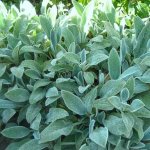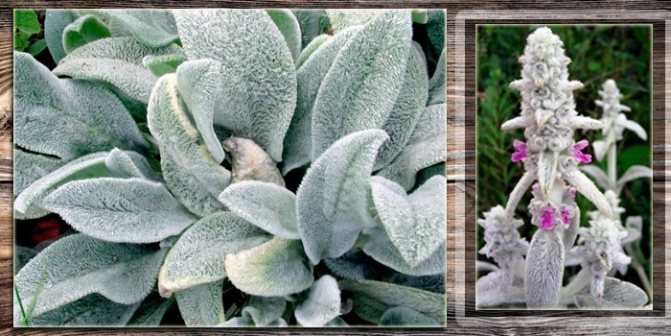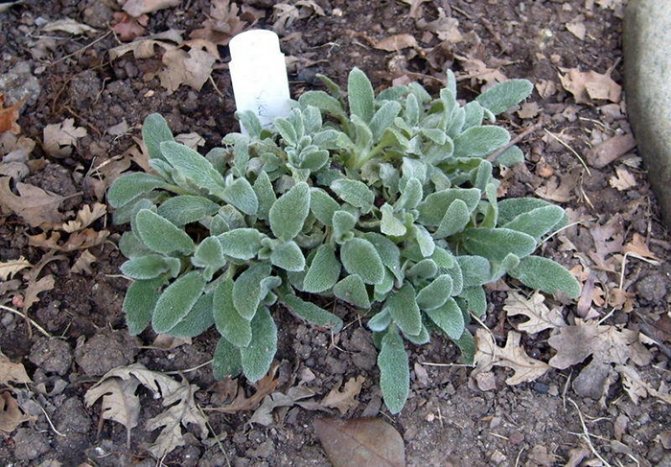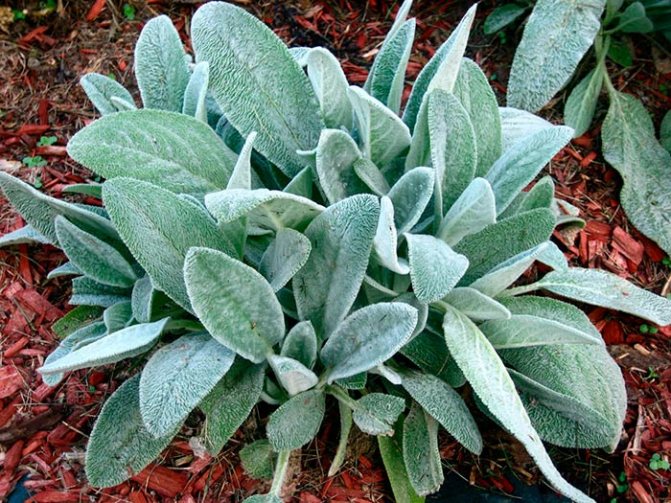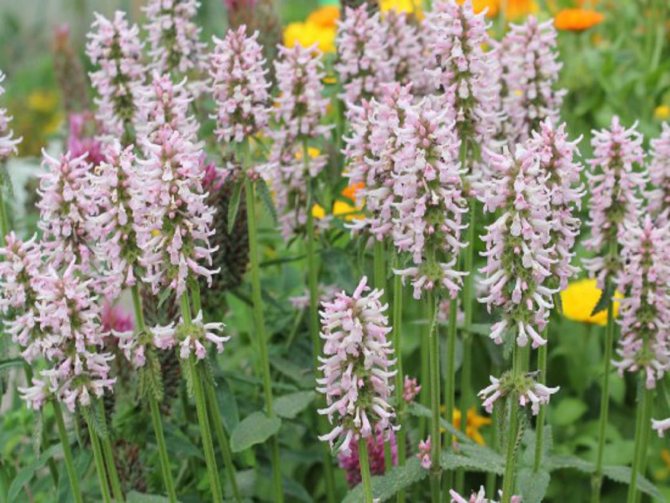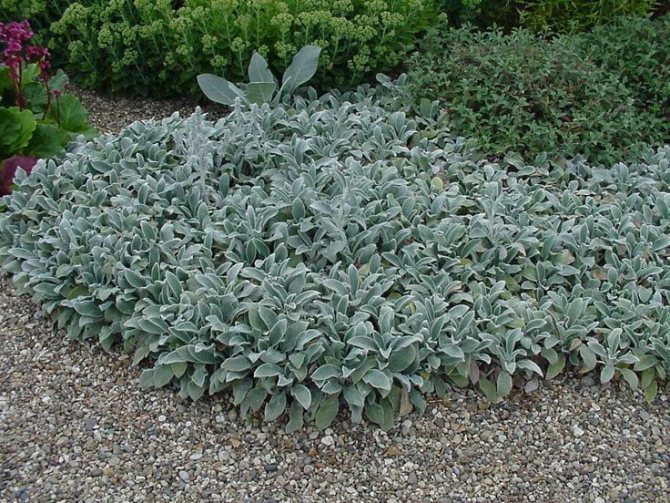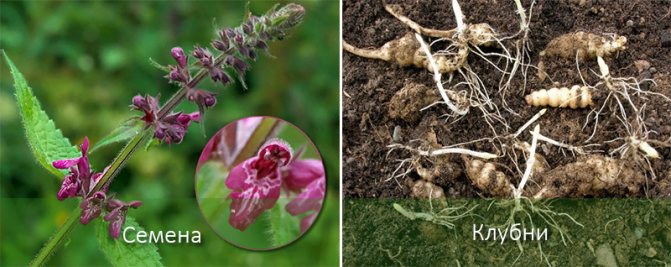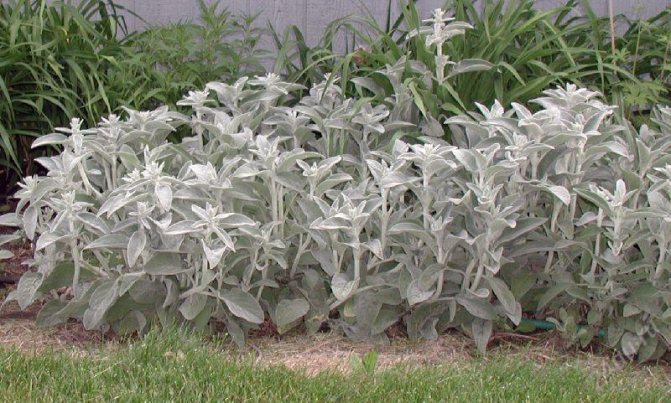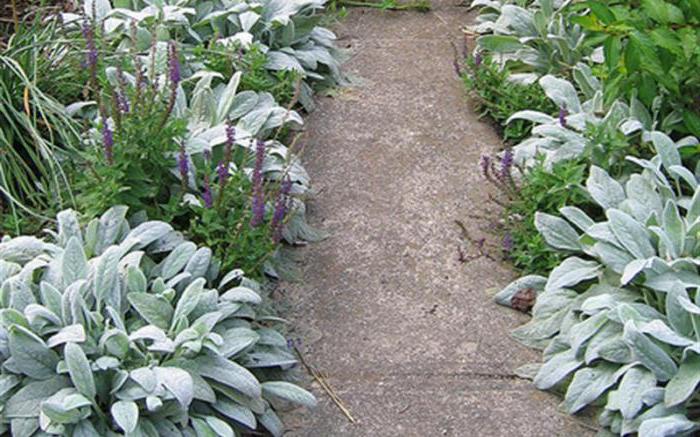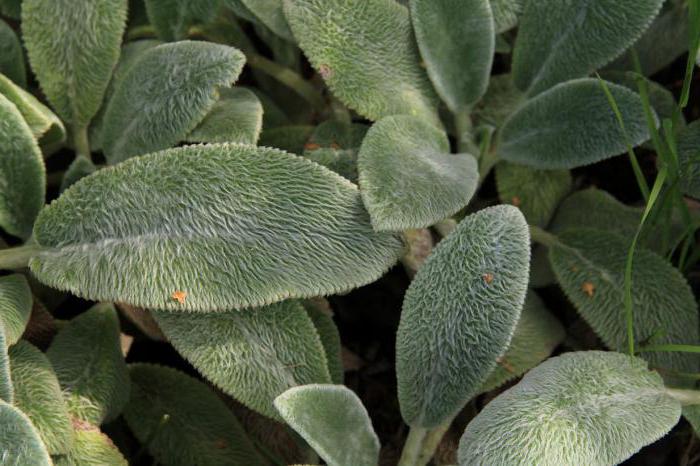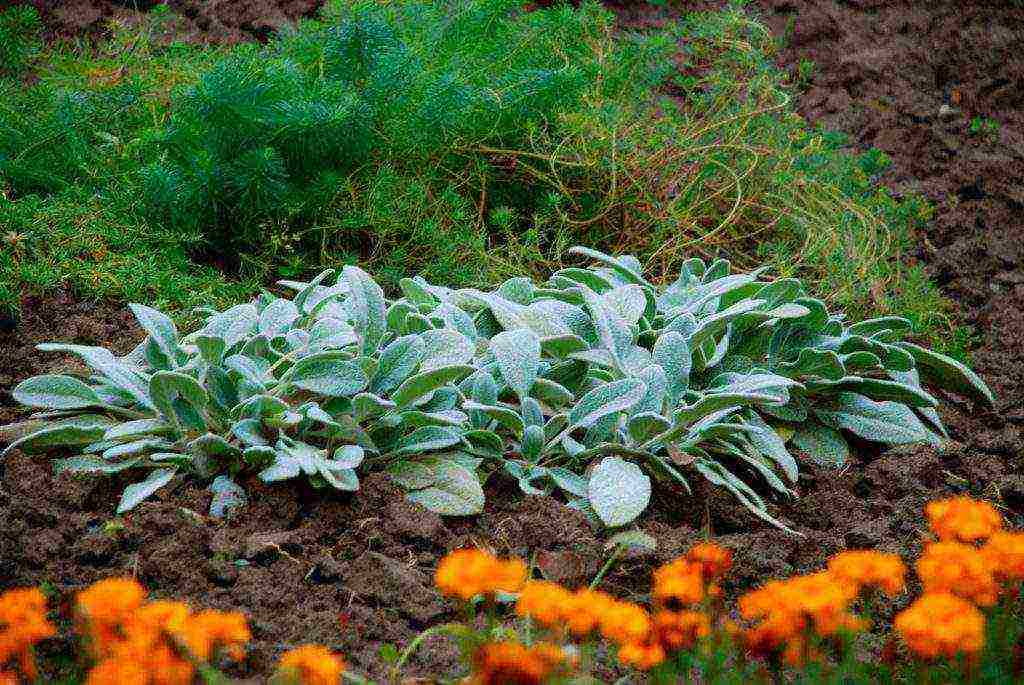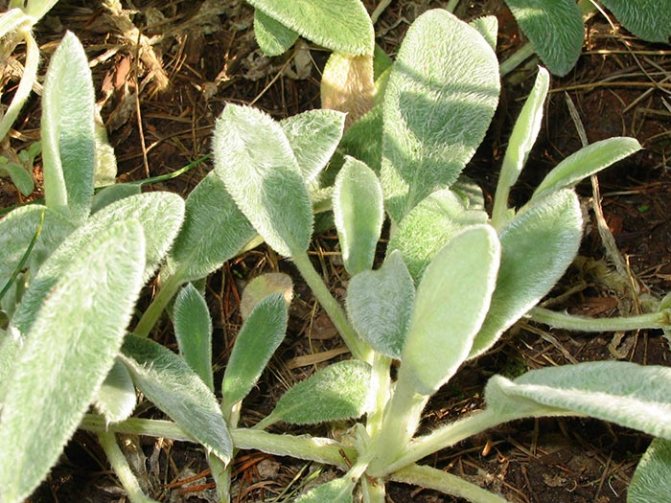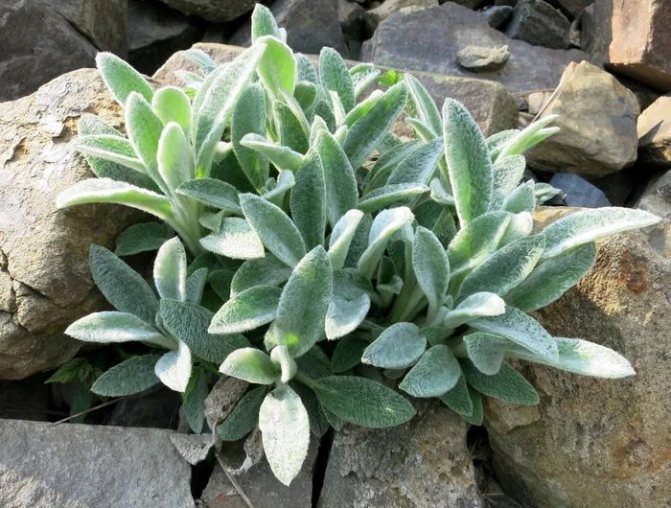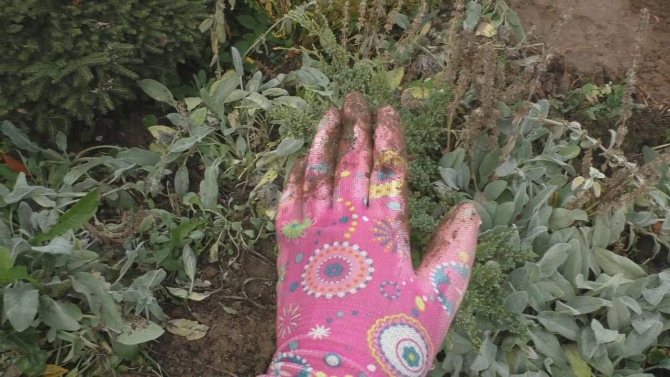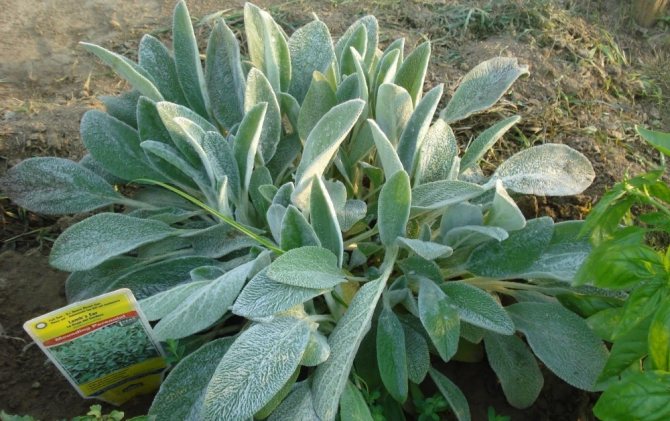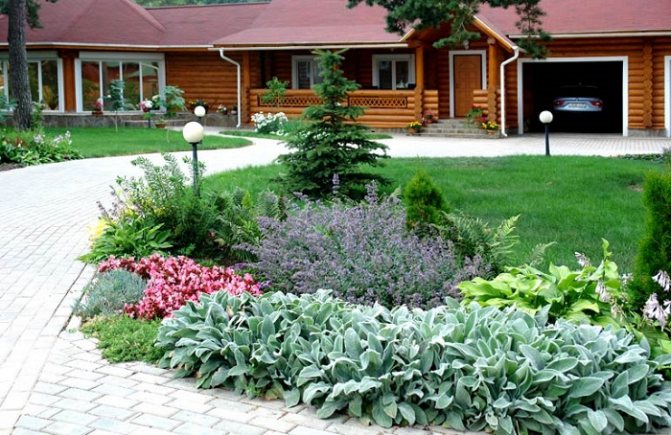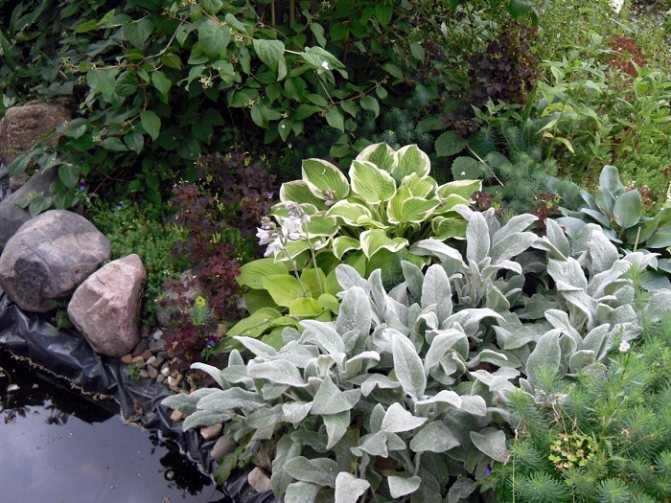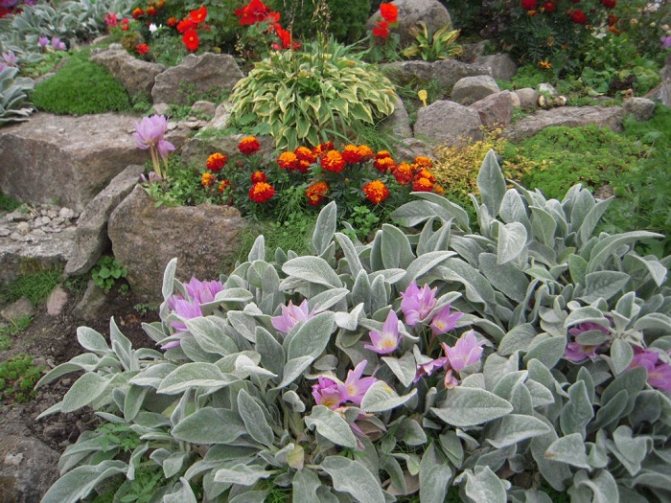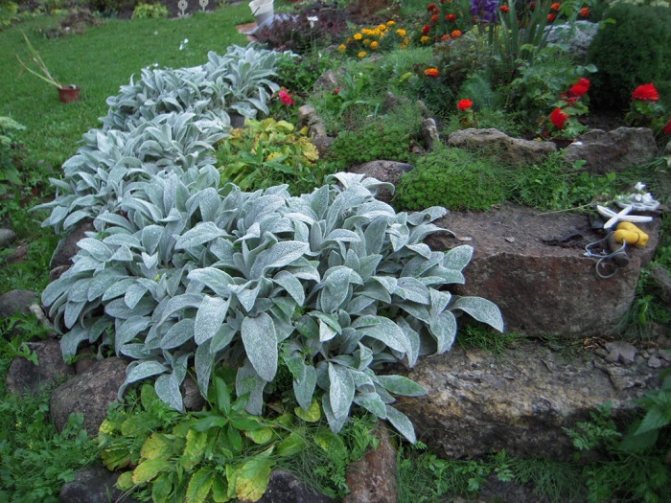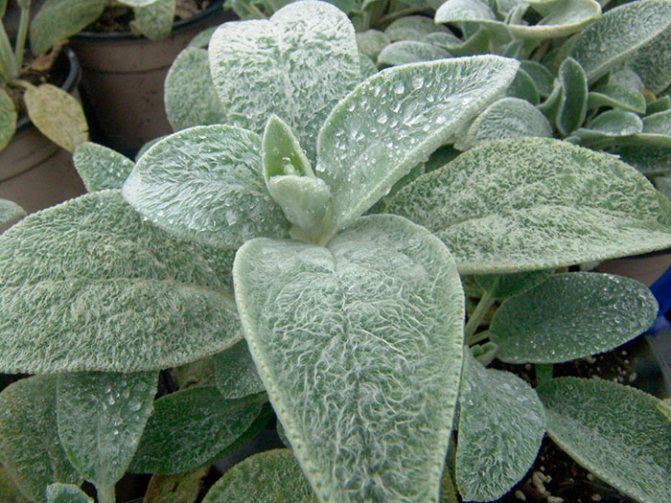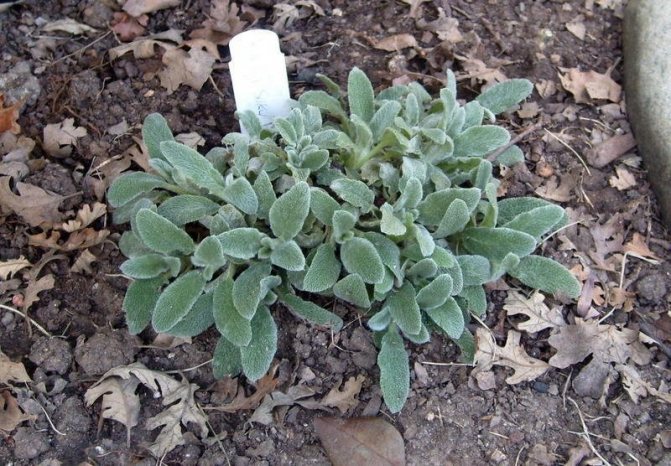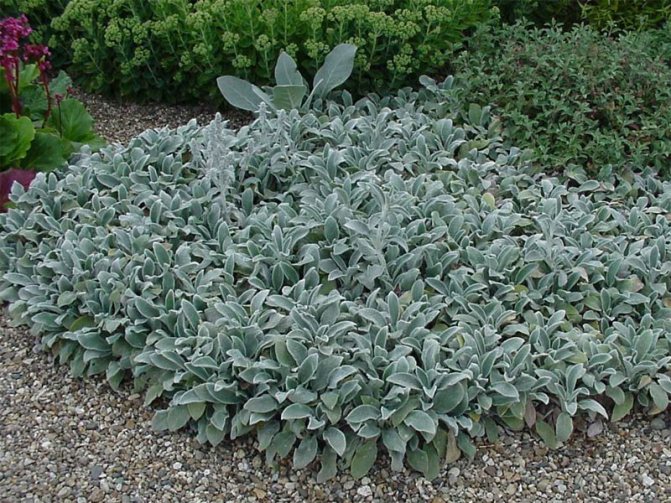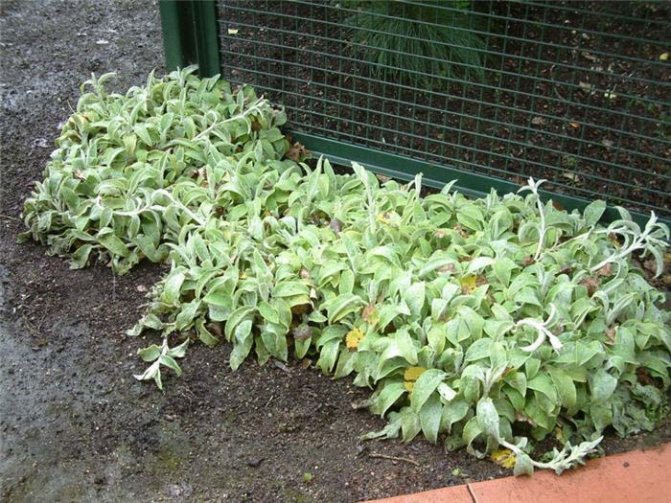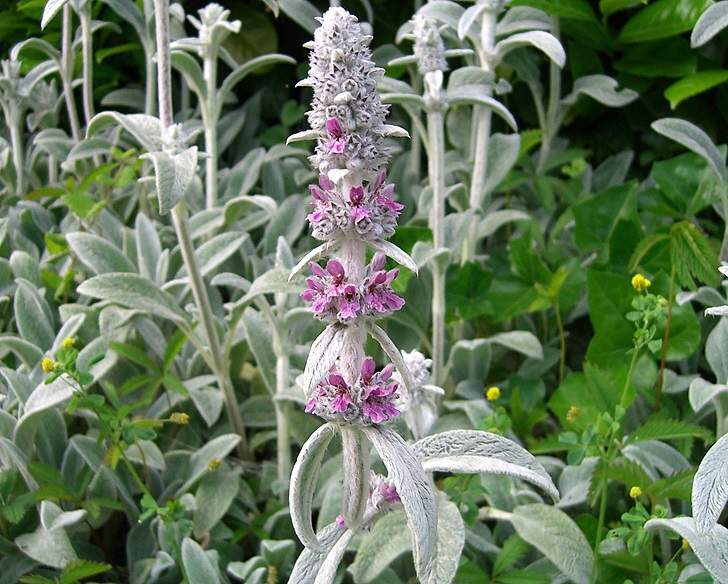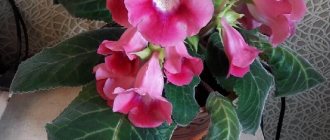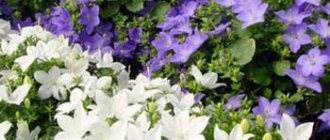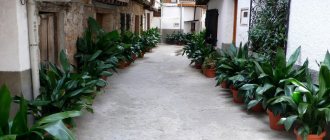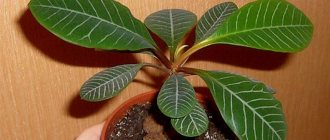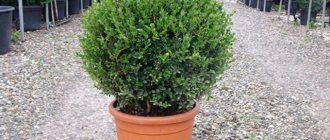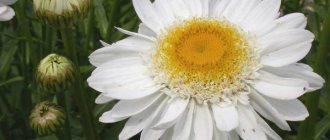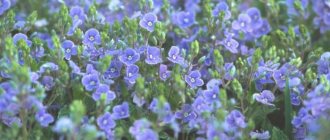This amazing plant of the Yasnotkov family has several names: woolly stachis, sheep's ears, Byzantine chisel. Its homeland is China, and it came to Europe only at the end of the 20th century, but has already gained immense popularity among gardeners.
In nature, there are more than 400 varieties and species of this plant, which are both perennial and annual, herbaceous and semi-shrubs. But woolly varieties are more decorative and unpretentious.
Woolly stachis is a semi-shrub with low, straight stems (about 50-60 cm in height) and long narrow leaves. A distinctive feature of the plant is a long and thick silvery pile that completely covers all its leaves and shoots. At the tops of the stems, spike-shaped inflorescences of 6-8 small flowers of blue, purple, pink, white and yellow color are formed. Stachis grows best in the south and in central Russia, but it can be cultivated in more severe climates.
How to plant sheep ears
Seat selection
Best of all, the plant develops its foliage and shows its decorative effect in places open to the sun. The soil is needed loose, with good drainage and moderate fertility. The poorer the land, the finer and more silvery the foliage.
Preparing the soil for planting
The selected area is dug onto a shovel bayonet, and a bucket of sand per square meter is added to the heavy soil during digging. If the soil is acidic, you can add kg of chalk per square meter. meter. For sheep ears, neutral or slightly acidic soil is preferable. In very poor soil, you can add 5-6 kg of rotted humus or compost. The introduction of 40 g of superphosphate and 20 g of potassium sulfate per 1 sq. M. will also have a beneficial effect on the planted plant.
Planting methods: seeds in open ground and through seedlings
Sheep ears tolerate frost well. You can sow seeds in the fall. To do this, you need to make grooves in the prepared soil immediately after collecting the seeds. Sow seeds and cover them with soil. Shoots will appear in 8-10 days. Before winter, the plant will have time to grow a rosette of leaves. It hibernates, as a rule, without shelter.
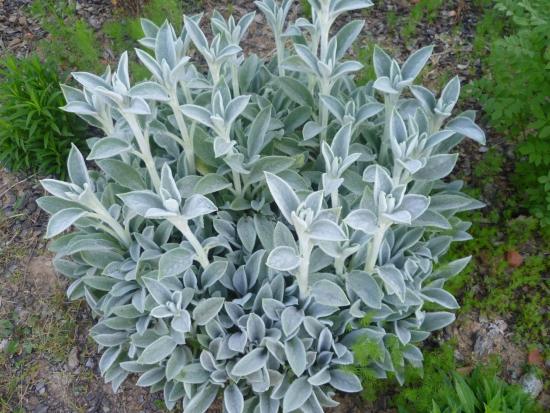
At the end of May, the plant can be planted in a permanent place. When grown through seedlings, seeds are sown in boxes at the end of March, planted in the ground at the end of May. Leave the distance between the bushes 15 - 20 cm. After planting, the plant needs to be watered.
Planting with nodules
Nodules can also be planted in fall and spring. The holes are made at a distance of 15 - 20 cm, the distance between the rows of holes is about 50 - 60 cm. The depth of the holes is 6-7 cm. The nodules germinate after about 10 - 14 days.
Planting by cuttings
For rooting, cuttings are cut with two to three leaves. Prepare a mixture of peat and sand, moisten it and deepen the cuttings by 1/3 of their length. After about 21 days, rooting will begin. Rooted cuttings are planted in a permanent place next spring.
Video
Planting by dividing
Once every 3-4 years, the mother bushes need to be dug up. This can be done not only in spring, but also in summer and autumn. Divide the plant into 2-3 parts and plant in a new place. The survival rate of stachis is very high. After transplanting, new bushes require moderate watering.
Sheep ears growing from seeds
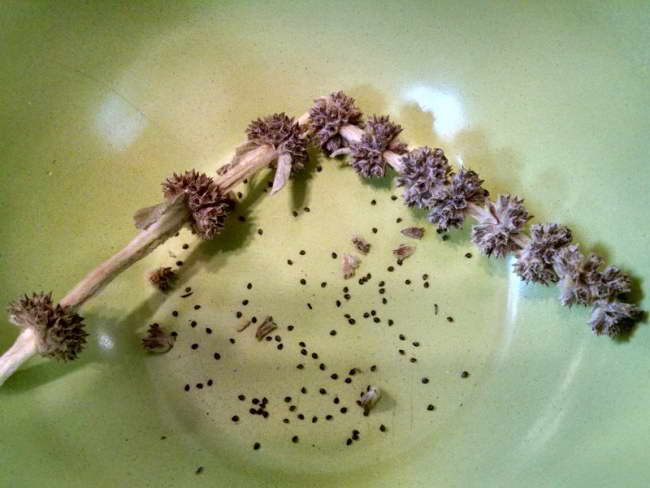

Chisel stakhis sheep ears seeds photo
In warm regions, they are sown directly into open ground in spring or before winter. Just dig up the area, sprinkle the seeds and cover with a rake. If your area has severe winters, it is best to take care of growing seedlings.
The seeds germinate quickly (from 5 to 10 days) and without problems, and the seedlings are tolerant of transplanting, they can even "wander" around the site several times per season.
- Pour the sand-peat mixture into a wide container, distribute the seeds over the top, sprinkle with a thin layer of sand and spray from a fine spray.
- You can germinate without shelter, just try to spray the soil daily, diffused lighting is required, keep the temperature within 20-25 ° C.
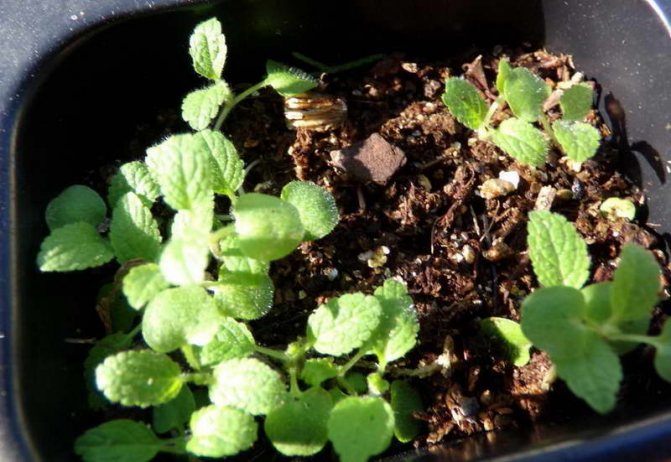

Sheep woolly stakhis sheep ears from seeds photo shoots
- If necessary, thin out dense seedlings; before transplanting into open ground, seedlings can be grown in the same container.
- Dig holes according to the size of the root system, transfer the seedlings together with an earthen clod, when planting, adhere to a gap of about 15 cm.
Chemical composition
Prickly or black gill contains:
- tannins and organic acids;
- keratinoids and pectins;
- essential oils and sugars;
- traces of alkaloids (stachydrin) and flavonoids.
The biological composition of the kolyutnik seed impresses with its 0.13% content of ascorbic acid, the presence of up to 44% of the vegetable-fatty base. Essential oils, iridoids, vitamins (K, C) suggest an extremely active antimicrobial activity that has a detrimental effect on the parasitic colonies of staphylococcus. Its peculiarity lies in its rapid development in the absence of immunity in the human body.
Pharmacological properties
The antimicrobial composition and vitamin formula are sheep's ears. The so-called black gill is actively used in medicine - they prepare drugs used to treat:
- hypertension, stuttering, neurosis and insomnia;
- heart failure, poor cerebral circulation;
- diseases of the female genital organs, profuse bleeding.
Agrotechnology of growing Byzantine chisel: secrets and nuances of care
Caring for the Byzantine Chisinau will not require much effort from you or a lot of your time. It is enough to occasionally pay your attention to it and in return you will receive a beautiful and very decorative plant.
- Watering. Byzantine chisel does not tolerate stagnant water at the roots, therefore, this plant must be watered very carefully, in moderation. It is recommended to water the plants only during dry periods. At other times, there is enough moisture for the roots. You can use a slightly different watering regime: once a week in small doses, with severe drought, the number of waterings increases.
- Loosening. It is recommended to loosen and huddle the soil around the plants regularly, as you increase the flow of oxygen to the roots.
- Top dressing. The Byzantine Chistess is calm about the application of fertilizers. It is enough to apply rotted manure or complex mineral fertilizer once or twice a season.
- Pruning. In the spring, it is important to remove last year's dry leaves in time. Also, throughout the season, you must carefully monitor the shoots of the plant, which need to be cut off if they grow strongly. If you want to see a beautiful and compact bush without glades, then it is recommended to cut the peduncles before the flowers appear. Thus, you will also get rid of self-sowing and headaches from removing weeds of the cleanser.
- Preparing for winter. In the southern regions, the Byzantine chisel does not need additional shelter, with the exception of young seedlings, which can be covered with spruce legs or fallen leaves. In more northern regions, plants must take shelter for the winter.
Planting a plant
You can start harvesting areas for planting cuttings, grown seedlings and rooted cuttings in the middle of summer. For 1 sq.m you need to add 20 g of potassium sulfate, 50 g of ordinary superphosphate and dig up the soil to a depth of 30 cm.Then select the roots of the weeds and add at least 10 kg of organic feeding.
In August, it is already possible to plant the future woolly chisel in a permanent place, distributing it at a distance of 30-40 cm between crops. The soil should be light (ideally - loamy and sandy loam), drained, not very wet, without stagnant water, properly fertilized.
Growing stachis from seeds using seedlings
The easiest way to plant woolly stachis is growing from seeds by seedling. This is relevant only for regions with a harsh climate, since in the southern and central regions, stachis can be planted immediately in open ground. For seedlings, seeds begin to be sown in late February-early March, having previously prepared the soil.
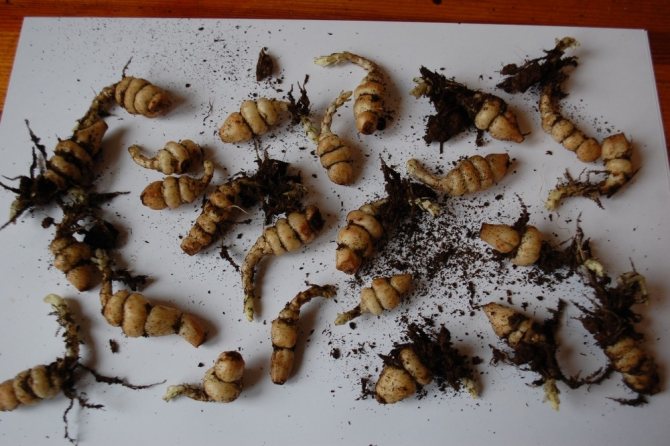

Woolly stachis is grown from seeds or tubers.
Important. The soil should be nutritious and fertile, with peat content. It is placed in wide containers of medium depth and slightly moistened.
The seeds are highly germinating and do not require any pre-planting treatment. They are slightly buried in the soil, watered, covered with glass or film and placed in a warm, sunny place. After 15-20 days, friendly shoots appear, and when two true leaves are formed, the seedlings dive and sit in separate pots or cups.
Planting seedlings to a permanent place in the garden
As soon as the threat of frost has passed (in April-May), young plants can be planted in open ground. But there are a few more opinions about when to plant stachis on the street. Some gardeners practice planting seedlings in August. In this case, the soil is prepared in advance, from mid-July. To do this, the site is dug to a depth of 30-40 cm and 20 g of potassium sulfate, 50 g of superphosphate and 10 kg of organic fertilizers are added per square meter. m.
The best place for planting stachis is considered to be an area with good sunlight, but the plant tolerates partial shade well. In the shade, the color saturation fades, the stems stretch and lose their decorative effect.
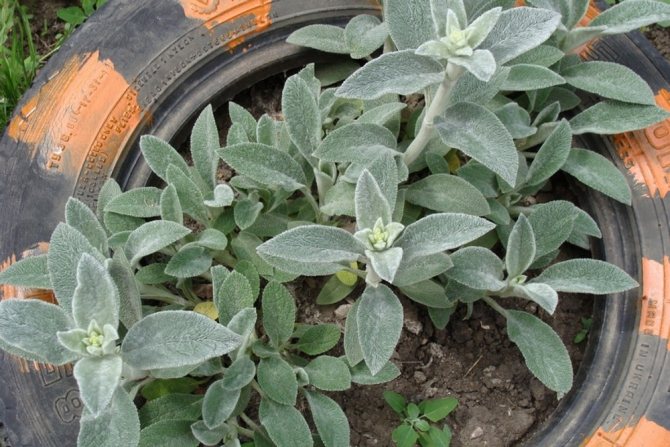

Stachis can be planted outdoors in May or August.
Important. Stachis sprouts are one of the first to emerge from under the snow, earlier than crocuses and tulips.
The plant is absolutely undemanding to the composition of the soil, but light, moderately fertile, sandy loam soils will be an ideal option for it. Woolly stachis is a cold-resistant and drought-resistant plant, does not like excessive waterlogging, but with moderate watering, the leaves grow larger, more juicy.
The roots of the plant are located very close to the surface, and it can grow in the same place for a long time. After a few years, the middle of the flower bed begins to age and thin out, therefore, once every 4-5 years, woolly stachis are transplanted to another, more fertile area.
In the selected area, shallow holes are dug, a drainage layer is laid on the bottom, a little soil is poured, young seedlings are placed and tamped. Such holes should be located at a distance of 20-30 cm from each other.
Stachis care, fertilization and feeding
Woolly scum is an example of unpretentiousness on the site. Caring for it is simple:
- Watering - once a week in small doses. During a prolonged drought, the volume of water and the frequency of its application should be increased, otherwise the plant risks dropping foliage.
- At the beginning of flowering, stachis will need hilling. Also, periodically loosen and weed the soil.
- Pick dry old leaves every spring. Watch out for overgrowing root shoots in summer. If they are not removed in time, they will creep apart and take over neighboring territories.
- Prune inflorescences regularly. Due to ripe buds, the bush may decay.
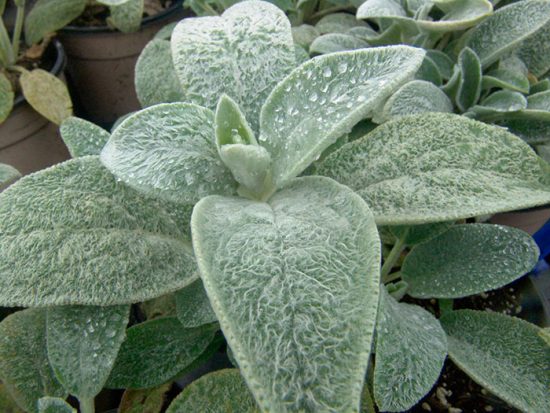

Water the sheep's ears regularly, but little by little.
- To avoid bald spots in a carpet planting, periodically plant young bushes in bare areas.
- Chisel is resistant to light frost. However, it is better to cover the plant during severe frosts. Pay close attention to winter weather. As soon as there is a thaw, remove the protective cover. Otherwise, the bush may flare up.
- With the aging of the plant, a void will appear in the center of the leafy rosette. Once every 3-4 seasons, new soil should be poured into this place and a young seedling should be planted.
Advice. Cut buds can be used for bouquets as dried flowers in combination with other flowers.
The scrub is unpretentious not only in care, but also in feeding. Fertilizer growers advise to make 1-2 times a year, in the spring. Use chicken or cow dung in combination with ammonium nitrate. Sometimes organic matter is replaced with complex mineral mixtures. Fertilizer will help increase the plant's resistance to frost.
The healing properties of the plant
All varieties of stachis have certain medicinal properties that are used not only in folk medicine, but also in pharmacology. As for woolly stachis, official medicine uses it less often. But it is an indispensable component for the preparation of various decoctions and infusions in folk recipes.
In the video, the florist talks about the woolly stachis plant and shows it.
This plant has a strong hypotensive and hemostatic effect, excellently helps in the treatment of eczema, tuberculosis. Decoctions from stachis leaves are used to reduce pressure, relieve stress, for colds, mastopathy. Due to their antispasmodic action, they can serve as a pain reliever.
Hare ears - healing properties
Hare ears is an ornamental plant that is successfully used as a medicinal herb. Both stems, leaves and flowers have healing properties. They contain a high concentration of essential oils, tannins, pectins and flavonoids. Also, the plant is rich in vitamin C, organic acids. Due to its rich composition, hare ears are used to treat many diseases:
- Infusion of plant roots has an antispasmodic effect, relieves inflammation.
- An infusion of dried leaves of the woolly purse is used for diathesis, gout, scrofula, as a remedy for the treatment of skin diseases.
- Fresh leaves are applied to wounds, cuts, bruises. Thus, quickly stopping bleeding. Applying the leaves of bunny ears will numb the affected area and relieve inflammation.
- The plant is successfully used during labor, helps in stimulating uterine contraction, and has a hemostatic effect.
- Alcoholic tinctures are effective in treating the nervous system as a sedative.
Variety of decorative varieties of the Byzantine purse
The chastetz has spread widely throughout the world and gained popularity among gardeners and landscape designers. This prompted breeders all over the world to start breeding new species and varieties of chitose. This also applies to the Byzantine purist, in the line of varieties of which there are very unusual and interesting plants, worthy of attention of true connoisseurs of unusual cultures. Consider the characteristics of the most popular varieties of Byzantine purity.
- The variety of the Byzantine "Silver Carpet". One of the most popular varieties of decorative culture, the very name of which speaks about its capabilities and appearance, about the ability to grow in the form of a carpet. It is a compact variety, the maximum height of the plant can reach 15 cm. During the active growing season, the plant grows rapidly and forms a dense and fairly dense carpet of gray-green leaves with a high silvery pile. This variety does not form flowers.
- A variety of the Byzantine "Big Ears". It is a compact and low bush, the main feature of which is considered to be long leaves.In length, one leaf plate can reach about 20-25 cm, which is why the foliage resembles ears. Leaves of a bluish-green hue with a silvery pile on the surface.
- A variety of the Byzantine "Striped Phantom". This variety differs from other representatives of the species in the color of its leaves. Light longitudinal stripes are clearly visible on the gray-green monochromatic surface of the leaf. Due to this, the Striped Phantom variety belongs to the variegated varieties of Chitlet.
- The variety of the Byzantine "Cotton Ball". Translated, the name of this variety literally means "ball or ball of cotton". This is due to the fact that the flower whorls resemble cotton bolls during blooming.
- The variety of the Byzantine purifier "Sheila Macqueen". According to some reports, this plant variety was named after a famous florist in the 40-60s, who worked at the royal court in Great Britain. It is a compact, low-growing plant that does not set flowers.
- Variety "Sheep ears". This variety of Byzantine chisel was named in this way because of the similarity of the leaves of the plant with the soft and fluffy ears of the animal. Compact bush up to 30 cm in height. It blooms with delicate purple-pink small flowers, which reach a maximum diameter of 1 cm.
- Variety of the Byzantine purist "Primrose Heron". This plant variety differs from other representatives of the species by the color of its foliage. In the spring, at the very beginning of the growing season, the foliage has a yellowish tint; over time, by summer, the leaves become the usual gray-green color. During flowering, small pink flowers bloom on long peduncles.
- The "Silky Fleece" variety. This plant can reach a height of 25-30 cm. It is a beautiful and compact bush, the leaves of which are white and densely covered with long silvery fibers.
- Variety "Marvel". This is a tall variety of Byzantine chiseta, the stems of which can reach a height of 50-60 cm.
This is just a list of the most popular varieties of woolen beetle among gardeners and landscape designers in Russia, which are often used to create bright and spectacular garden compositions. In addition to them, this plant variety boasts a wide variety of varieties.
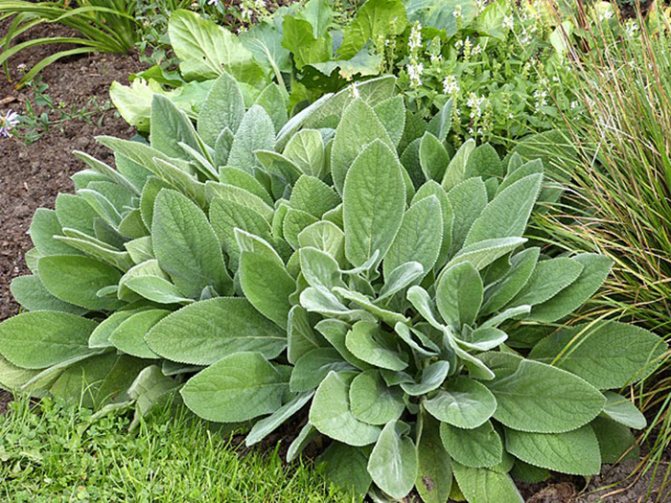

How to create favorable conditions for growing from seeds?
To grow stachis, it is required to prepare the soil with good drainage, in too damp soil it will quickly rot and die.
He also prefers open areas with a lot of light, therefore it is widely used in alpine slides for summer residents, in carpet plantings, as well as in curbs, it looks very elegant and noble.
Very well "hare's ear" tolerates frosts, which it can withstand without shelter, often without even dropping foliage, and prolonged droughts. In partial shade, it can also feel good, provided there is good air movement.
To preserve the decorative effect of the bush and avoid self-seeding, you need to cut the flower stalks, preventing the formation of buds.
Also, when the lower leaves are gone, it is a signal that the plant has aged, you need to plant young bushes in order to avoid bald spots.
Woolly chisel, he is stakhis, he is sheep's ears:
Types and distribution
In the wild, Woolly Chisel is found in mixed and coniferous forests, sometimes it grows in the steppe territory. Ornamental varieties of Siebold's garden stachis impress with a variety of shapes and lengths of gray leaves, color of flowers and other botanical features:
- "Marvel" - a kind of tall, drop-flowering plant reaches 50 cm;
- Striped Phantom is a variety with brightly colored leaves;
- "Sheep ears" - stem 30 cm long, lilac-pink dicotyledonous spikelets;
- "Silky Fleece" is a shrub 25 cm high. It has a pubescent light green crown and purple honeycomb whorls;
- "Big Ears" (Big Irz) - a variety with huge elongated leaves 25 cm;
- "Sheila Macqueen" - squat shrub that does not form peduncles;
- "Cotton Ball" - the spikelet forms rounded spikelets of a silvery shade;
- “Primrose Heron” - pink flowers appear against the background of yellow leaves in spring;
- "Silver Carpet" is a low-growing plant up to 15 cm high, forming a solid silvery carpet. Used to decorate flower beds in the area adjacent to the house.
Propagation by leaves
For breeding a plant such as a rabbit ears flower, it is easiest to use this particular method. The leaf is simply cut off with a sharp knife and stuck into the wet sand. Before this, it is advisable to sprinkle the tip with charcoal powder. The leaf takes root very quickly. Soon young plants appear on it. They bloom in the third year. Hemantus is transplanted once every 2 to 3 years as the bulb grows. If this is not done, the plant may stop blooming. The transplant should be carried out as carefully as possible. It is highly undesirable to damage the roots of this plant. Otherwise, it will start to hurt.
general description
The leaves of the hemantus have a deep green shade. The plates themselves are quite wide and thick. They grow vertically upward in pairs, and their tips hang down on both sides, which gives them the appearance of hare ears. Usually up to 4-6 leaves grow in one pot. In an adult hemantus, their length can reach 30 cm.The height of the peduncle is 20-60 cm.
The rabbit ears flower is a bulbous plant, and therefore does not like stagnant water very much. In the pot, you need to arrange good drainage for it. The bulb of this indoor flower is very large - up to 12 cm.
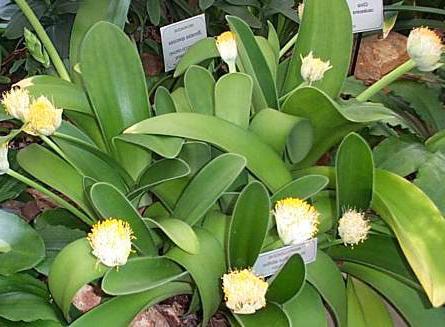

In winter, the hemanthus has a rest period. This plant propagates by seeds, daughter bulbs and leaves. Its main features can also be attributed to the very slow regrowth of leaves. Also, apartment owners who want to purchase this plant should be aware that it can cause allergic reactions.
Seat selection
Stakhis is a rather unpretentious plant to care for. The culture will feel great in the open sun and, at the same time, will not fade. It tolerates drought well enough. If you plant a purse in partial shade, he will also not mind.
Under constant sunlight, stachis grows very large distinctive leaves, the color of which is slightly whiter than that of its "brothers" living in the shade.
However, to think that this culture can live in complete drought, like a cactus, would be a fatal mistake. This threatens that the bush will simply throw off all its leaves in order to survive, because it will not be able to saturate them with trace elements and water.
Therefore, if the summer is too hot and dry, then the soil needs to be moistened from time to time. However, flooding the plant with a lot of water will be no less a mistake than not watering it at all. More severe drought, the culture does not like only stagnant moisture.
What kind of soil should our woolly friend choose? In this case, most of the known soil compositions are suitable:
- sandy;
- stony;
- alkaline;
- black soil.
An ornamental plant does not take its roots too deep. Basically, the root system is superficial, which is what makes the crop so versatile in soil selection.
In addition, you do not have to replant stachis from place to place every year. He will feel great in one place for several years. However, in the fifth or sixth year of the growing season, the middle of the plant's flower bed may begin to thin out. The purifier will help save additional cultivation of new seedlings in other places, a complete transplant of the flower bed in a place that is more saturated with useful minerals or fertilization of the soil.
Stakhis will be ready to move to another "place of residence" as soon as the spring night frosts are over, but it will be best to wait until May. When transplanting an entire flower bed, it must be borne in mind that each seedling should be at a distance of about 20 cm from its neighbor.Before planting, it is recommended to apply fertilizer to the soil; this can be done with the help of manure, humus, or simply add chalk to it.
If you are replanting a stachis that has lived a carefree life for five years, then you need to dig out a part of the earth under it and add a new one, rich in microelements, in its place. After that, it remains only to plant our seedlings in a fertile place.
Agricultural technology of the Chinese artichoke: how to grow stachis
Stakhis, although a rare plant, is by no means pampered - unpretentious, frost-hardy, grows on any soil, except for acidic ones. The agricultural technique of the Chinese artichoke is similar to the agricultural technique of Jerusalem artichoke (earthen pear) - if you can grow Jerusalem artichoke, then growing stachis is a piece of cake for you.
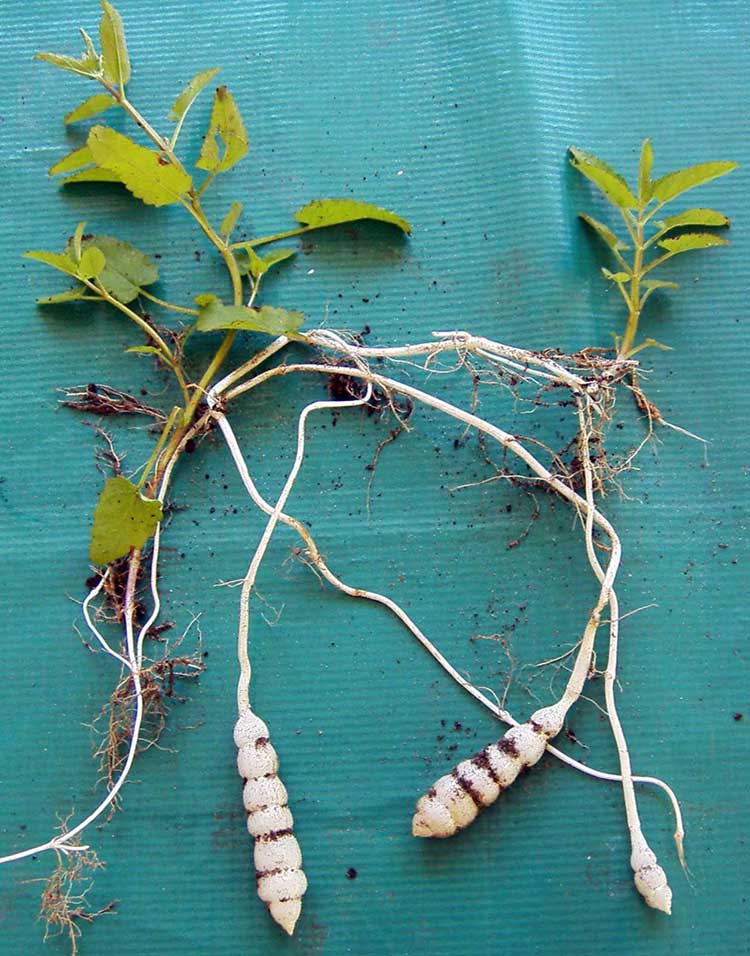

Stachis tubers are at a decent distance from the bush. Photo: Grower Jim
The place for stachis should be flat, well-lit by the sun, with light fertile soil. Avoid planting Chinese artichokes in waterlogged areas and places where water stagnates in spring and autumn. It is desirable that there is no wireworm in the soil. Wireworm is the main pest of stachis.
The scoop also causes great damage to stachis, so it is not recommended to plant the Chinese artichoke after all types of cabbage, as well as after potatoes. The best predecessors of stachis are tomatoes, onions, cucumbers, bell peppers and eggplants.
It is customary to grow Stachis like a potato - like an annual plant. The site for the Chinese artichoke must be prepared in the fall: digging the earth with a shovel bayonet or more, fertilizing (1 tbsp. A spoonful of superphosphate, 1 tsp. Potassium sulfate, half a bucket of mature compost per 1 m2 of beds). In the spring, the soil must be loosened and added 1 teaspoon of ammonium nitrate for each square meter.
The main feature of growing stachis is that it is recommended to plant it in the fall (at least in early spring) due to the fact that the seed tubers of the Chinese artichoke are difficult to preserve without a good cellar with about zero temperature. You can plant tubers without fear of frost.
Therefore, immediately after harvesting the tubers of the Chinese artichoke, it is recommended to sort and plant the largest ones in grooves with a depth of 7–8 cm, observing a distance of 30 cm between tubers and 50 cm between rows. After planting, the soil must be leveled with a rake.
In spring, Chinese artichoke entrances appear in 2-3 weeks. During this time, the site has time to be tightened with weeds, therefore, immediately after the emergence of shoots, the stachis must be weeded out. When the tops grow 15-20 cm, it is necessary to feed the Chinese artichoke with mineral fertilizers and be sure to loosen the aisles with a hoe to a depth of 10-12 cm.
As the stachis bushes grow, especially in August, you only need to weed by hand - you can damage the tubers with a hoe. Remember that stachis tubers are formed far from the stem (40-50 cm). In August, there is an intensive formation of tubers, which means that the risk of damage to tubers is maximum.
In July-August, if the weather is dry, the Chinese artichoke needs watering, only in this case a large crop of tubers is guaranteed.
Harvesting of Chinese artichoke tubers begins in October. Early harvest does not give the maximum number of marketable tubers - tubers grow more intensively in September. It is necessary to dig the tubers with a pitchfork or a shovel, carefully lifting the stachis bushes and shaking off the tubers to the surface of the ground. The optimal yield is 120-150 tubers per bush.
In winter, the tubers of the Chinese artichoke are stored in a cellar at temperatures from 0 to + 2 ° C and a humidity of about 90%. Stachis tubers are well stored in boxes and covered with soil, like the root crops of carrots and beets. If it is not possible to store stachis tubers at a low temperature, you can dig up part of it in the fall, and leave the other part in the ground until spring, and then dig it up.
If the need for spring digging has disappeared, then after the emergence of seedlings, the plants can be transplanted to a new place like seedlings.In general, among lazy gardeners and truck farmers, stachis can go into the category of weeds, which are difficult to get rid of, which once again proves the unpretentiousness of the culture.
I wish you to grow a decent harvest of stachis and defeat diabetes!
Stachis: combination with other plants
Delicate and fluffy sheep ears look great in many landscape compositions in the garden. They are used to decorate flower beds, paths, borders, rockeries, alpine hills. The purist will accentuate and highlight bright flowers: marigolds, lavender, campanula, ageratum, etc. It also looks good in combination with soft shades of geyher, milkweed, yaskolok and cuffs. Sometimes the plant is used for bouquets.
Sheep ears are unusual due to the appearance of the leaves. Take advantage of this feature and add a touch of warm sophistication to your garden design.
Woolly stachis in landscape design
Silver-gray stachis densely covers the soil with its long, creeping shoots and lush leaves. It will perfectly complement any composition on the flower beds, decorate the borders. It goes well with a cuff or milkweed cypress, bright marigolds, two-color cross, lavender and yaskolka.
Looks beautiful with ageratum and Carpathian bell. Stachis is irreplaceable when decorating alpine slides and rockeries, because it grows well even on stony and poor soils.
Use in traditional medicine
Microscopy of the forest letter suggests the content of vitamin C, tannins that support the human body. The presence of flavonoids and other substances has a mild analgesic effect. The herb is able to initiate contraction of the intrauterine muscles. Alcohol-based preparations are being prepared to counteract high blood pressure, problems with an intense heart rate. A decoction of gill roots is used for gastrointestinal disorders, with the addition of leaves, it relieves tuberculous coughs and colds. The drugs have no contraindications.
Restoring sleep, a positive effect on the nervous system, is observed on the basis of regular intake of home remedies, brewed with a dry mixture of woolly thistle. The fight against skin manifestations (scrofula, gout) is carried out by applying a steamed monier herbal mixture to the diseased surface. Fresh leaves are used for abscesses, bruises, cuts. Homemade tampons, compresses and lotions from stachis help well with mastitis, in gynecology, dermatology.
See More: Medicinal Application of Adonis vernalis
Experts recommend taking alcoholic tinctures in the postpartum period to stop bleeding, heal wounds (lotions, tampons). To restore the menstrual cycle, drink decoctions of the leaves.
Tincture recipes
The biogroup includes Stakhiren, a substance that fights high blood sugar levels. By creating a store of glycogen in the liver, the marsh chase works on the principle of insulin. Correctly prepared infusion of Byzantine stachis is useful to drink with uterine bleeding.
Useful properties of stachis
Stachis tubers are beneficial for human health, due to the increased content of selenium, which is a powerful antioxidant and immunomodulator, as well as trace elements: potassium, calcium, magnesium, copper, zinc, etc.
Stachis is eaten fresh (green leaves in the form of a salad) and boiled. When boiled, stachis nodules taste like cauliflower.
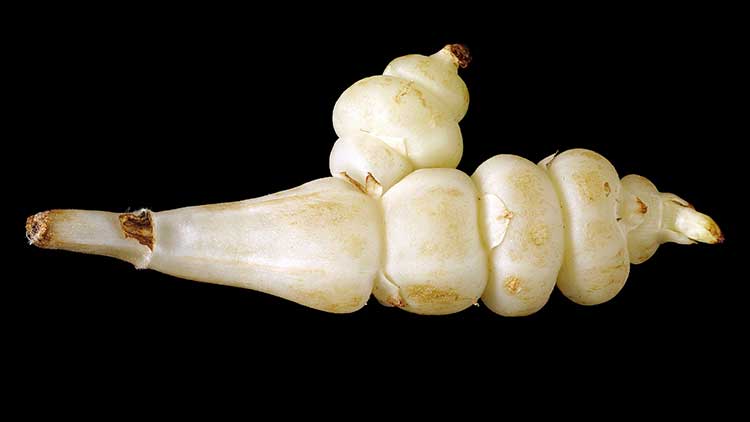

Chinese artichoke tubers taste like cauliflower
There is no starch in the tubers of the Chinese artichoke, so diabetic patients can eat it quite calmly, without fear of blood sugar levels. Stachis is especially useful with increased blood clotting in diabetics, due to the increased content of stachyose. Stachyose has an effect similar to insulin - it lowers blood sugar by up to 50% and cholesterol by 25%.That is why the Chinese artichoke must be introduced into the diet of patients with both type I and II diabetes.
Stachis tubers are capable of even age-related metabolic disorders: fats, proteins, carbohydrates and minerals. It has been scientifically proven that the use of stachis tubers prevents the development of cancerous tumors.
To preserve the full healing potential of Chinese artichoke tubers, they are stored fresh or dried at an elevated temperature (no higher than + 60 ° C). Too high drying temperature dramatically reduces the nutritional and healing value of tubers.
Diabetics are recommended to use sandwiches with chopped dried stachis tubers, as well as salads, where the Chinese artichoke is present fresh.
Diseases and pests of rabbit ears
Provided proper watering, the woolly chick practically does not get sick and is not attacked by pests. Excessive soil moisture and planting in shaded areas of the garden makes the plant susceptible to fungal diseases. Fungicides are used to fight the fungus. If the fungus could not be defeated, the affected bush should be dug up and burned to prevent infection of the entire planting.
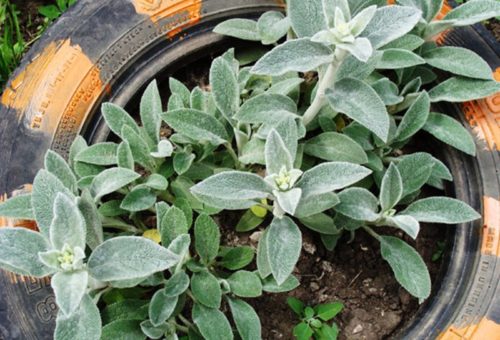

Diseases and pests dangerous for stachis, and how to deal with them
Pests almost never attack woolly stachis. Of the diseases, fungal lesions are most common. This is caused by waterlogging of the soil and stagnant water.
Stachis diseases:
- gray rot;
- blackleg;
- root rot.
These diseases cannot be defeated, they can only be prevented. Therefore, it is necessary to plant plants in high, dry areas that are not subject to flooding and stagnation of rainwater.
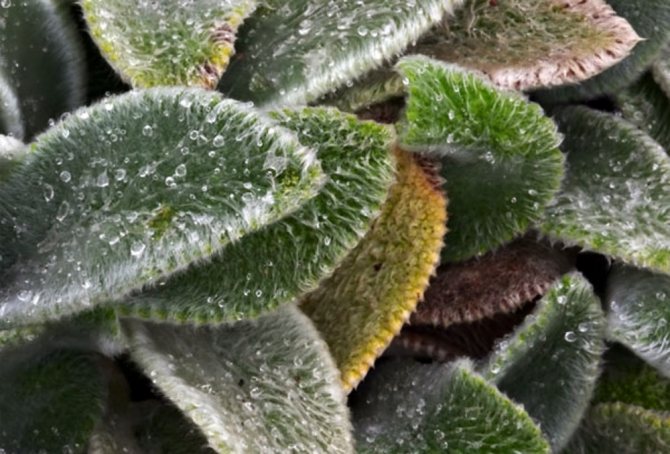

With strong waterlogging of the soil, the leaves of the stachis may turn yellow.
Division of bushes
Quite often used method of stachis breeding. From a developed bush, it is necessary to separate part of the foliage along with the root system. This method will allow you to get a new plant in a fairly short time, therefore, it is preferable to use this method for propagating a culture. You can plant and divide the bush at any time of the year, except for winter, which is another plus of dividing the bushes. The most important thing is that there is no scorching sun outside. Therefore, the best time for stachis breeding by dividing the bushes is the end of August, since the weather is still warm enough, but not the same as in the scorching July sun.
Landing of the Byzantine purge
The Byzantine chastetz is a beautiful and decorative bush that fits perfectly into any landscape design. At the same time, planting a culture will take a minimum of time and effort, and in the future, the purist will delight you with its unusual beauty. To get a healthy and strong plant, it is important not only to properly plant the seedlings, but also to carry out competent preparatory work. Consider the whole process of planting a Byzantine purifier in separate stages.
Stage 1. Choice and purchase of planting material of the Byzantine purse
- First of all, every gardener needs to purchase high-quality and healthy planting material.
- If an adult plant of this species is already growing on your site, you can use one of the above propagation methods.
- If you do not have an adult bush and you have no desire to engage in crop cultivation, then you can buy ready-made seedlings or seedlings of the Byzantine purse in specialized garden shops or nurseries that are professionally engaged in plant breeding.
- Most often, the stores sell seedlings in the form of seedlings in separate pots.
- Before buying, it is important to carefully check the appearance of the planting material. Young seedlings should be free of visible damage, yellow or rotten areas. The soil in the pots must be clean and moist.
- When choosing planting material for the Byzantine Chisinau, pay attention to the botanical features and appearance of a particular variety. So you can choose a plant suitable for you, both in height and in the color of foliage and flowers.
Stage 2. Choosing a place for planting the Byzantine purifier
- The second important step is to choose the most suitable place for planting on your site.
- The Byzantine Chistess prefers to grow in open sunny places, where there is always plenty of sunlight and warmth. This allows you to get a beautiful neat bush with large and silvery leaves.
- You can plant this crop in light partial shade, but in this case, the size and color of the foliage will be more scarce.
- It is important to plant seedlings of this variety on small hills or slopes, where there is no constant stagnation of water, which can have a detrimental effect on the plant itself.
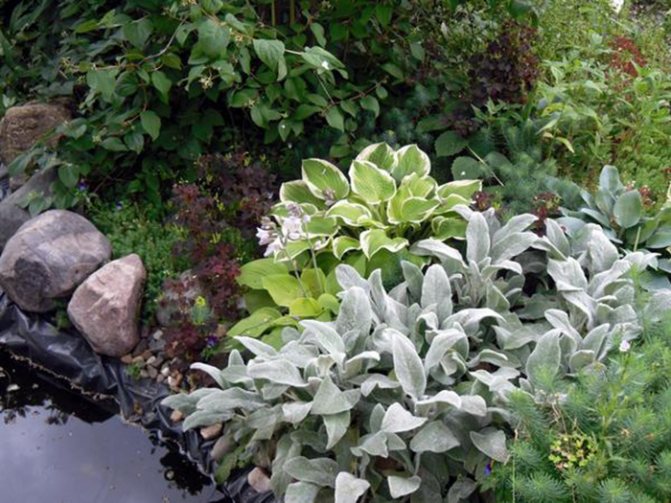

Stage 3. Selection and preparation of soil for planting the Byzantine purse
- The Byzantine purse is considered an unpretentious plant that takes root well on any soil. It will grow on sandy soils, rocky or loamy soils.
- Ideally, it is recommended to plant young seedlings on light, moisture-permeable soils with a neutral or alkaline reaction.
- If the soil of your choice is acidic, then it is recommended to deoxidize it using charcoal or lime.
- The main condition for choosing a soil for planting a Byzantine purse is good drainage, since this plant does not tolerate stagnant water at the roots.
- Before planting, you must carefully dig up the place you have chosen for about two bayonets of a shovel, since the root system of the plant is quite long.
Stage 4. The technology of planting the Byzantine purse
- It is recommended to plant seedlings of this plant in open ground in May after the threat of recurrent frosts has passed.
- On a site selected in advance, it is necessary to prepare planting pits, the size of which should be slightly larger than the root system of the seedlings.
- It is important to remember that the planting holes must be placed at a distance of 15-20 cm from each other in order to make room for the growth of bushes.
- At the bottom of each pit, place a small layer of drainage, which may consist of small stones or gravel.
- Next, add a layer of potting soil consisting of sand, peat and humus.
- Seedlings in pots must be watered abundantly before extraction, and then rolled into the holes together with an earthen clod.
- On the resulting mound, place a seedling of a chasteer and carefully sprinkle it with soil.
- After planting, young plants are watered abundantly.
Sowing seeds in open ground
The plant can be propagated by planting seeds in open ground in the spring, when the threat of night frosts has passed, or in the fall, just before the onset of winter frosts. Slightly frozen soil may also be suitable for planting, but it will need to be warmed up well.
It is very important to ensure that the outside air temperature is not lower than 8 ° C, but also not higher than 20 ° C. About 10 days after planting the seeds, the plant will give its first shoots. The percentage of germination, as in the case of germination of planting material in room conditions, is very high. After that, it will be possible to plant young crops, observing the standard distance between seedlings of 15-20 cm.
Other ways of planting and breeding
There are several methods of stachis reproduction, including not only sowing for seedlings, but also dividing the bush, grafting, sowing seeds and tubers in open ground.
Sowing seeds in open ground
This planting can be done both in spring and autumn. The main thing is that the air temperature does not fall below + 8C. When sowing for the winter, the seeds are sown thicker, in case of freezing. It takes about 2 weeks from planting to the appearance of the first shoots. When the seedlings are strong enough, they are planted in the flower bed with an interval of 15-20 cm.
Division of bushes
The simplest, but no less effective way of breeding.A part of the bush is separated from the adult plant along with the roots. This can be done not only in spring, but also in autumn, and even in summer, best of all in August. With this method, the plants are thinned out, given more room to grow, and the planted parts of the bush take root well and bloom after a couple of months.
Propagation by cuttings
Woolly stachis is successfully propagated by cuttings.
For cuttings, the lower part of the plant stem with 3-4 leaves is suitable. The cut site is treated with wood ash, and the cuttings themselves are placed in shallow containers filled with a mixture of wet sand and peat for rooting. The roots appear very quickly, after which the cuttings, without deepening, are planted in a permanent place in open ground.
After 10-12 days, the first shoots and leaves appear on them. It is better to carry out the cuttings procedure in the fall, but spring sowing is also good. It is necessary to constantly monitor the condition of the soil, avoiding waterlogging or dryness.
Tubers
Tuberous propagation, which is carried out in early spring, gives good results. Small tubers are separated from an adult stachis, placed in prepared holes, 6-8 cm deep, covered with a layer of humus and watered. The distance between future plants should be at least 20 cm.
Woolly stachis tubers are inedible, unlike some other varieties and plant species.
Application area
The scrub is used in different directions due to its unique biological composition.
| Stachys byzantine, monier | ethnoscience | Landscaping, gardening | Cooking |
| Leaves | Make decoctions, infusions | Propagation by cuttings | The Stachys sieboldii variety is cooked in batter. Add to salads. Vegetable casseroles. Omelet with leaves and peas |
| Flowers | Used for the preparation of decoctions, tinctures | Added to tea blends | |
| Roots | Squeeze out the juice | ||
| Seeds | Make oil, use it for medicinal purposes | Growing seedlings | |
| Whole plant | Along the edge of curbs, flower beds. Low-growing varieties are used as a background. Seated by dividing the bush |
Use in the garden
Soft and delicate leaves of an unusual silver color are perfect for framing paths and flower beds. Chisel can be used in alpine slides, rockeries and in the foreground of bright flower beds. The plant looks beautiful in the vicinity of marigolds, ageratum, veronica, bells and other blooming flowers. It also perfectly sets off the charm of decorative leafy host, milkweed, geyher and cuffs.
Stachis can be used not only in plantings, but also in bouquet compositions. The leaves retain their attractiveness in a vase for a long time.
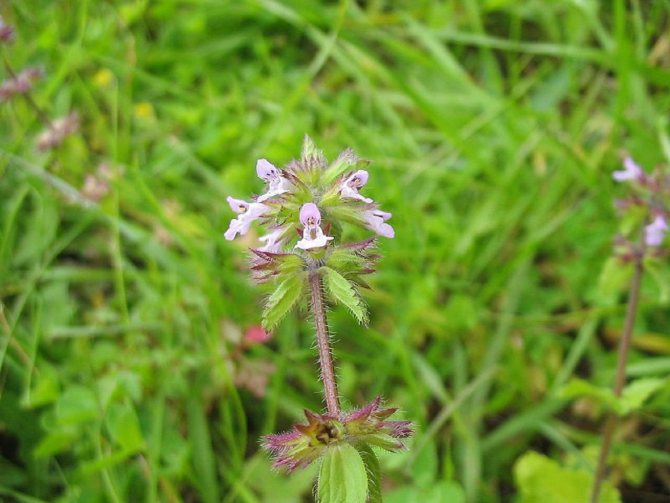

Diseases and pests of the woolly beetle
Proper grooming is a key factor in stachis health. If you overdo it with moisture or plant a plant in the shade, then its resistance to fungal infections will dramatically decrease. It is not difficult to identify the causative fungus and compare it by photo on the Internet. Usually, measures to combat it are reduced to treating greens with a special fungicide. In advanced cases, the infected parts should be removed and burned immediately. The plant does not suffer from pests.
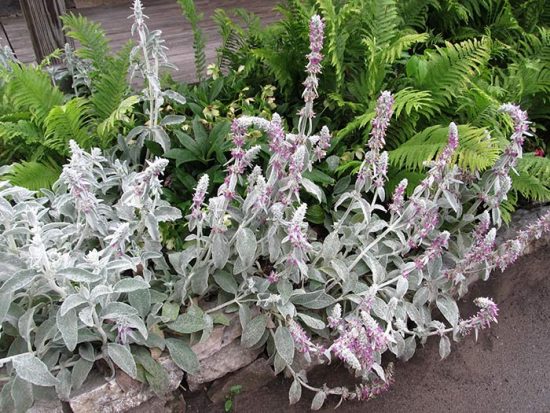

Sheep ears in landscape design
Features and description of the Byzantine purifier
Chisetz is an extensive genus of dwarf shrubs or herbaceous perennials and annuals that belong to the Lamb family. Byzantine chisel is a perennial herbaceous rhizome plant that has high decorative qualities and value. The temperate climate of Eurasia, North and South America and Africa is considered to be the natural habitat of the Chisel. The most popular type of Byzantine chisetz in nature is widespread in the southern part of Russia, in the Transcaucasus and in some regions of the Mediterranean. To date, there are more than 300 varieties of the purée, which have spread almost all over the world and began to be grown as an ornamental and medicinal plant.
Byzantine chistess has a number of names, including woolly chisetz or stachis. People often hear that this ornamental plant is called "bunny ears" or "sheep ears". This name was given to the Byzantine chastets because of its decorative foliage, which from the very beginning of the growing season is densely covered with silvery hairs. The leaves are soft and pleasant to the touch. The plant got its scientific name "stachis" because of the shape of the inflorescences, which resemble a spikelet. In translation "stachis" means "ear".
The Byzantine Chistess is widely used in landscape design due to the fact that it fits perfectly into any garden composition. The silvery silk carpet of an overgrown bush bush will be an excellent backdrop for brighter flowering plants or will harmoniously fit into an ensemble with an artificial reservoir. In recent years, gardeners have been using this plant not only as a decorative component of the landscape, but also as a medicinal crop.
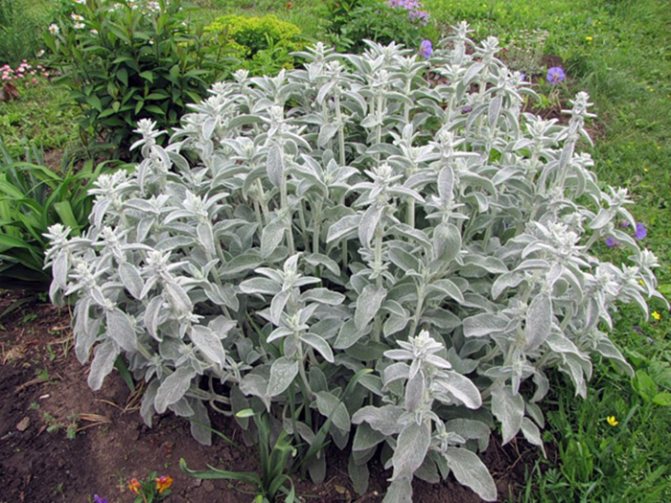

Description of the Byzantine purist:
- Byzantine chisel is a perennial herbaceous ground cover plant that has a high ornamental value.
- This plant is referred to as creeping crops, since the rhizome of the chitose plant grows very quickly into clumps up to 1 m in diameter. This feature is used to create beautiful compositions, where the Byzantine Chisinau acts as a spectacular background.
- The root system of the culture is rather long, but weakly branched, extending deep into the ground vertically. Young tubers appear on thickened root shoots, which can be used for propagation of this plant.
- The height of the whole plant is formed by the size of the shoots with leaves and peduncles. The Byzantine chisel can reach a height of only 20-30 cm, however, during flowering, tall peduncles rise above the leaves up to 30-40 cm in height. Therefore, the total height of the bush can reach 50-60 cm.
- The bush is formed by dense and thick shoots that have little branching and contribute to the rapid growth of the plant. The stems are strong and have 4 edges.
- The leaves of the Byzantine purse are the main decoration and value of the plant. Leaves are basal and stem. They differ slightly in size and shape.
- Basal leaves have a lanceolate or heart-shaped shape, in length they can reach 10-12 cm. They are attached on short petioles and are located on the shoots alternately.
- Stem leaves are lanceolate-ovate and may be slightly smaller than basal leaves.
- There are varieties of Byzantine chiselae with large leaves, which can grow up to 25 cm in length.
- All leaves are painted in a monochromatic gray-green shade and are densely covered with long silvery hairs, making the leaves seem like felt and resemble animal ears.
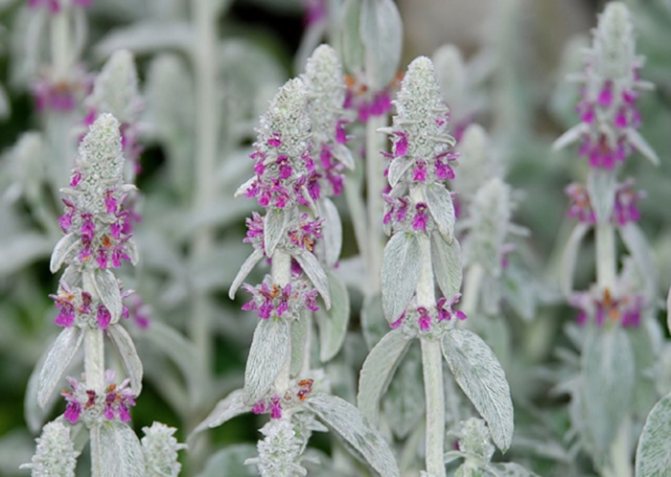

- During the flowering of the Byzantine purse, which falls at the end of June or the beginning of July, long peduncles appear on the plant, reaching a length of 30-40 cm. At the ends of the peduncles, up to 20 cm long inflorescences in the form of spikelets bloom.
- The flowers are small, have the shape of a bell-shaped calyx with five pointed petals, and can reach 1 cm in diameter. The shade of flowers of the Byzantine purist can be pale pink or pale lilac.
- The flowering of this plant lasts about two months until September. The flowers have a pleasant aroma that spreads throughout the site.
- Many gardeners remove the stalks before flowering, thereby increasing the number of ornamental leaves. This is due to the fact that during flowering, the bushes can become loose and less beautiful.
- After flowering, an oval nut with three sides is formed in place of the inflorescences, in which the seeds of the Byzantine purse ripen. They can be used for culture propagation.
- This culture is distinguished by good resistance to cold and frost resistance, which makes it possible to grow an ornamental plant in the temperate climate of central Russia.
- The Byzantine Chisetz or Woolly Chisetz is used to create landscape design. Gardeners use it to frame garden paths and borders, to decorate rockeries and alpine slides, as a ground cover plant. This plant looks great as a tapeworm, in this case it creates a silvery carpet from its unusual leaves.
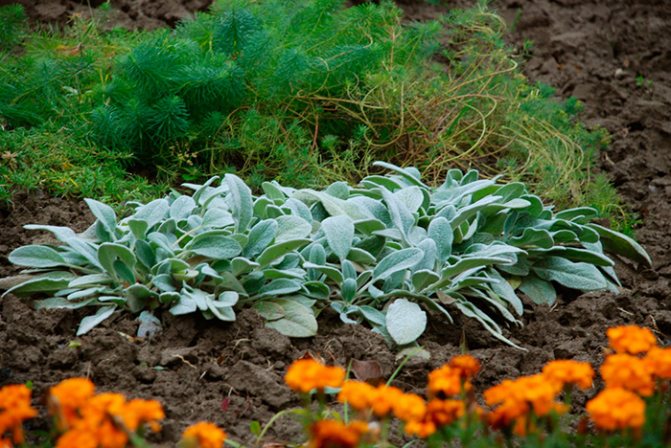

Botanical description and classification
A spreading tall or creeping bush with a stem from 20 cm to 60 cm is a woolly stachis, planting and care of which is required in spring, summer and autumn. The roots are in the surface layers of the soil, well developed. The plant loves loose, drained soil with fertilized fertilization. It takes root well in partial shade, in open sunny areas. The shrub tolerates winter frosts and is ready to prune old leaves and stems in spring.
In Russia, gardeners grow creeping shrubs for flower bed decoration, rockeries. Stachys byzantina, translated from Latin, the name reads as Byzantine chistess: it belongs to the family Lamiaceae, genus Stachys. Felt chickweed in nature has up to four hundred species. The geography of distribution looks like this:
- stakhis settled in the south of Russia (Siberia, Altai);
- found on the Crimean Peninsula, Ukraine, the Caucasus;
- perfectly acclimatized in Turkey, Iran, Morocco, Armenia;
- grows in the Mediterranean countries.
A representative of the Lamiaceae family can be tall or squat: the creeping species grows up to 15-20 cm, and a perennial with long flowering calyx reaches 50-60 cm. It develops dark green leaves surrounded by a white edge (silvery white villi). Beginning in June, it forms light pink whorls, lilac-lilac honey-bearing tops, and on some varieties yellow dense spikelets about 20 cm long. Bright multi-colored shades pleases the eye until the end of Indian summer. In warm climatic zones, stachis propagates by seeds. The name from the Latin word Stachys literally meaning "ear" was fixed due to the elongated inflorescence. And thanks to the lush leaves, reminiscent of the oval shape of the ears of a small lamb, the plant received the name "Sheep Ears".
Learn more: Common hawthorn species: description, application
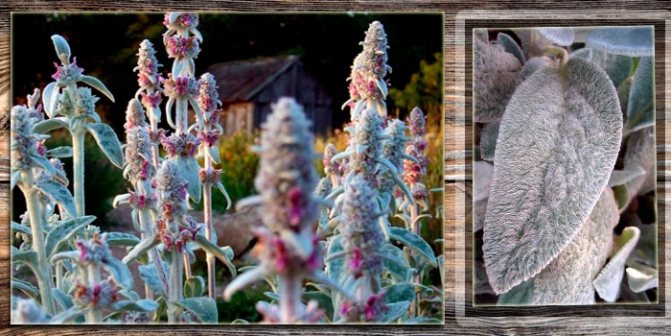

Gardeners and designers appreciate the perennial Monnier "Humello" for its noble outer leaf, shimmering with light silvery shades. It adds a sophisticated look to the flower bed, acting as a curb shrub. It is successfully mixed in rockeries with other popular plants. There is also a woolly beetle on flower beds next to children's playgrounds, recreation areas. The structure of the sheet evokes extremely soothing emotions, a cheerful mood.
Common varieties and varieties of plants with photos
Of all the species of woolly stachis, only 15 are grown in culture, and the rest are wild-growing.
The most popular cultivars are:
- Cotton Ball - a low bush, blooms in the form of a large spikelet, consisting of neat cotton bolls;
- Big Ears is a compact plant with long (up to 20-25 cm) fluffy leaves;
- Silver Carpet and Sheila Macqueen are non-flowering ground cover varieties with short shoots and very densely growing leaves;
- Primrose Heron is a very beautiful plant with bright yellowish leaves and pink flowers, collected in large inflorescences.
In addition, there are other interesting varieties of woolly stachis, for example, Silky Fleece, which is a small shrub with completely white, fleecy leaves and purple flowers. Or Striped Phantom - a very interesting plant with variegated leaves.
Recommendations for planting and caring for the plant
The purifier does not have any special care features, since it is quite unpretentious, it is only recommended to water it under the roots, and do not spray water on the leaves.
Once a year (preferably in spring), you can fertilize with rotted compost. It tolerates transplants very well, so you can safely transplant from place to place.
It is better to take an alkaline or neutral soil with a pH of 7 for planting, add a little chalk or dolomite flour, well-rotted compost to it.
At the same time, do not get carried away with fertilizers - on rich soil, the leaves of the purist will lose their silvery and become bright green. And if the bushes, on the contrary, are bare and stretched out, then the soil is too dry and poor in trace elements.
The purist is almost never affected by pests, but in damp conditions it can suffer from fungal diseases.
The land for sowing must be prepared in advance, enriched with superphosphate (50 grams per 1 sq. M) and potassium sulfate (20 grams per 1 sq. M) in a couple of months.
If the planting is done from boxes, then try to leave up to 40 cm between the plants for growth.
Chistets is ideally combined with lungwort, silvery wormwood and heuchers. These plants are companions, they have a beneficial effect on each other.
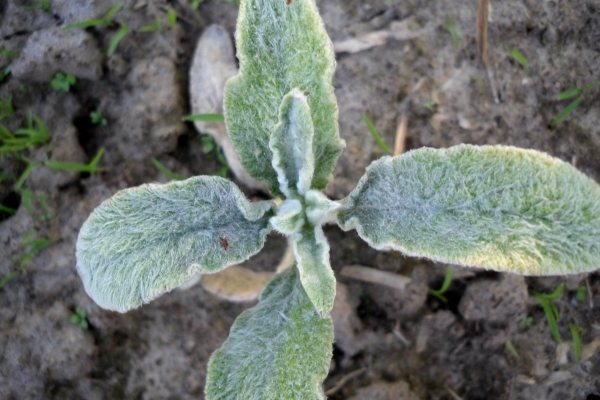

Water the plant at the root, fertilize with compost in the spring, take the soil for planting neutral or alkaline
Companion plants
Woolly stachis looks great on any flower bed. It can be planted separately from other plants, or you can come up with various combinations and combinations. But for this you need to know exactly what flowers and shrubs it can coexist with.
The best companions for stachis are:
- Woolly stachis is combined with many colors.
bells;
- hosts;
- geycher;
- silver wormwood;
- astrania;
- lavender;
- ageratum;
- bloodroot;
- lungwort;
- splinter.
Stachis looks great surrounded by sheep, marigolds and rose bushes. You can combine these plants in different ways, but the result will always be great.
Care Tips
Woolly stachis is a rather unpretentious plant in planting and care, when choosing a soil and a place for planting. However, even such a culture can keep several important secrets.
Loosening the soil, weeding and watering
As noted earlier, stachis feels great in dry soil and does not tolerate stagnation of water. Watering the crop should only be done in hot and very dry summers. On ordinary spring-autumn days, it is not recommended to water the plant.
Lack of moisture on summer days can be noticed by the fall of the foliage. It is necessary to water the culture in the evening, when the sun shines at a sufficiently large distance. Several young seedlings can be planted in the soil in the spring, since old specimens can stretch out, discarding young leaves, and because of this, voids will form in the flower bed, which are best closed for decorative purposes.
If the leaves and stems are too elongated or completely dry, then it is recommended to cut them off. Do the same with the rhizome throughout the summer, which will come out from time to time.
A lump of watering in the summer, stachis requires careful soil care. From time to time it must be loosened, even though the culture does not give deeply growing roots. This procedure is recommended every two weeks.
The plant can be hilled at your discretion, but you can do this no more than 3 times per season, since this way you give the stachis room to develop, and this can lead to overgrowth. You should not rush to loosen the soil. Only do this when the leaves are about 20 cm long.
As for fertilizers, the crop does not need frequent feeding. It will be enough for her to get a portion of compost once a season. In the spring, young seedlings can be planted in such soil.
Pruning inflorescences
As you have already noticed from the description of the culture, stachis is an ornamental plant.It is considered ideal for curbs, lawns or streams. Of course, the deciduous part of the plant is valued much more than its thin stems, on which the cap of unsightly and small flowers is located. It is difficult to imagine how much force the stachis gives in order to release such an arrow.
Naturally, this is all compensated for with new arrows that die or if new leaves do not develop. But for decoration we need everything to be the same, on the contrary, what to do?
In order for deciduous velvet to be saved, the arrows of the inflorescences must be constantly trimmed. The shorter the pruning is done, the better it will affect the development of the leaves. The optimal time for such a procedure is considered to be the period immediately after the first flowering is full.
If it was not possible to cut the plant before this, then next year it is necessary from the end of April or the beginning of May to closely monitor the formation of new shoots - cut them off immediately without regret. As soon as warm sunny days come, the plant will give, during the period of active growth, all its strength to the foliage, which over time will cover the earth and delight the horticultural eye with its luxurious appearance until the first frosts.
If the winter turned out to be snowy and frosty enough, then replanting the plant to a new place is not recommended. Stakhis will cover himself with a snow blanket and calmly overwinter, and in the spring he will again delight his master with velvet shoots.
In the event that the winter turned out to be dry, but frosty, then it is recommended to cover the plants for the winter season under a dense film, and protect the root system with a layer of mulch.
Wintering stachis
In the southern regions, the plant does not stop growing at all in winter. In the central and northern regions, subject to a snowy and frosty winter, stachis does not need shelter. Before wintering, they simply cut off all the leaves and stems and insulate the roots with snow. If the winter is expected to be frosty and without snow, then a good shelter from spruce branches or sawdust is required.
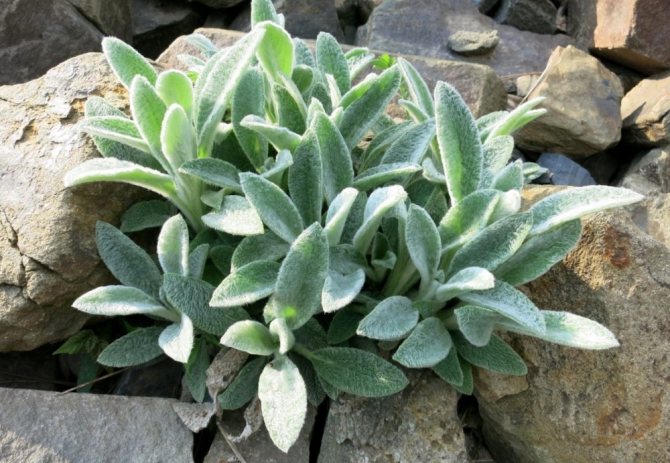

Before winter, all stachis stems and leaves are cut off, and the plant is covered with snow.
Planting a hemantus
The rabbit ears take a pot for a flower shallow, but at the same time wide enough. There should be approximately 5 cm of free space from the edges of the bulb to its walls. Hemantus soil can be bought at the store. A universal soil option is perfect for this indoor flower. But if desired, the soil can be prepared independently. Its composition should be as follows:
- sheet land - 1 part,
- turf - 2 parts,
- sand - 1 part,
- peat - 1 part,
- humus - 1 part.
When planting a hemantus, one important rule must be observed - the bulb should not be completely buried in the ground. At the end of the procedure, the flower is watered.
[collapse]
Care
Hare ears - indoor flower, characterized by unpretentiousness. You can fertilize it from time to time with a complex dressing for indoor flowers. But the plant will develop well enough without performing this procedure. Organic fertilizers are contraindicated for Hemantus.
Watering the rabbit ears flower should be moderate. If the water is stagnant, the bulb may vanish. However, it is undesirable to allow the soil to dry out in the pot.
The rabbit ears are cut off, the care of which is extremely simple, as necessary, removing dried leaves. It is also necessary to remove the peduncle after the formation of the ovary. Over time, he will die off himself, however, it can spoil the appearance of the hemantus for a long time. This plant also does not require spraying. Humidity of 60%, usual for city apartments, is enough for him. The only thing is that it is imperative that the plant be provided with abundant diffused sunlight. It is best to put the flower on the window on the west side of the apartment. On warm days, it is advisable to take the plant out to the balcony or garden. In this case, you need to place it in partial shade. Hemantus should not be left in the sun. Otherwise, burns will appear on its leaves.
For the winter, the rabbit ears flower, the photo of which you can see on the page, should be removed to a room with an air temperature of about 15 grams. However, this plant tolerates a good dormant period even being just shaded. Watering in cold weather is reduced. The lump should remain practically dry.
Woolly chisel (Stakhis, Stachys): grown in a flower bed and in a rock garden. Photo
The names are synonyms: Woolly Chistets, Stachis, Stachys, "Sheep's Ears", Byzantine Chistets, Byzantine Stachis, Stachys byzantina, etc.
.
Woolly chisel, or stachis (Stachys), known to many as "sheep's ears", is a perennial herbaceous rhizome plant, grown in our gardens as an ornamental, although it has a number of other useful qualities. The correct botanical name for the plant is Stachys byzantina. In the scientific classification, it belongs to the genus Stachys of the Lamiaceae family, which numbers about 400 species. It occurs naturally in the warm latitudes of Russia, Ukraine, the Caucasus, Crimea, Armenia, Turkey, Iran.
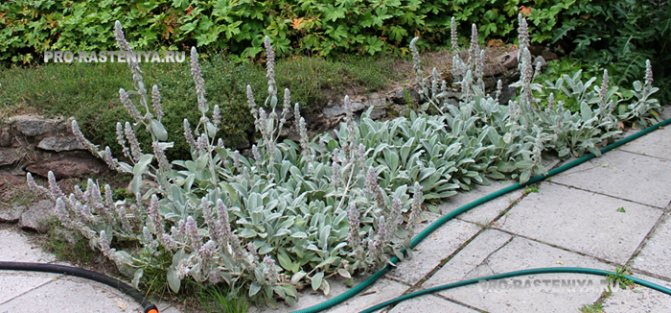


Photo: Woolly chisel in a border planting
Woolly chisel is a small semi-shrub 30-60 cm high with spectacular gray-green leaves, densely covered with silvery-gray villi, and pale pink or pale lilac flowers, collected in inflorescences resembling ears of up to 20 cm long.Stachis blooms in June and lasts until September. In warm climates, the plant produces many seeds and multiplies by them. For the shape of the inflorescence, the woolly chisel once received the Latin name Stachys ("ear"), and because of the densely pubescent leaves resembling lambs' ears, it is called everywhere "Sheep's ears".
Due to its attractive appearance, unusual color and texture of leaves, Woolly Chisel is popular among landscape designers and amateur flower growers. It is appreciated for its spectacular leaves that give the site or garden an exquisite and noble look. Woolly chisel is planted as a ground cover and curb plant, as well as in mixed plantings on alpine hills and rockeries. The woolly net is very good for children's flower beds and children's recreation areas. After all, its leaves are so pleasant to the touch: soft, warm, fluffy.
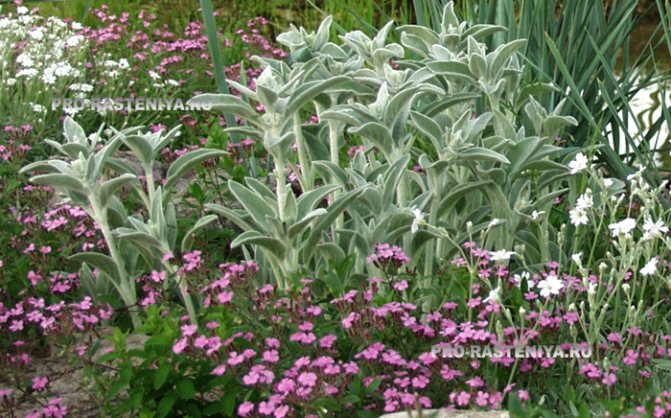

Photo: Woolly chisel in a rock garden framed by a yaskolka and a soapstone
Among the various varieties of woolen chitose there are undersized varieties with white flowers or not blooming at all: • "Marvel" - the height of the stems up to 50 cm • "Sheep ears" - height 30 cm, pinkish-lilac flowers • "Big Ears" - the size of the leaves reaches 25 cm long • "Cotton Ball" - this variety does not form stems and flowers, propagates only vegetatively. • "Primrose Heron" - the color of spring leaves - yellow, pink flowers • "Sheila Macqueen" - undersized variety that does not form flowers • "Silky Fleece" - a plant 25 cm high with purple flowers and fluffy white foliage • "Silver Carpet" - the most well-known undersized variety, height no more than 15 cm, does not form flowers, covers the soil with a solid silver carpet • "Striped Phantom" - variegated variety
Growing and care
Woolly chisel is planted in a sunny place or in partial shade. The more sun the plant receives, the silvery its leaves will be. Woolly purse prefers light, non-nitrogen-rich, loose soils with a neutral or alkaline reaction, well drained. When grown in a rock garden, the plant is placed in places without stagnant water, on the slopes.
Being an unpretentious plant, the woolly purse does not need regular fertilizing. Only once a season does he need to add rotted compost. The plant is drought-resistant, but during dry hot seasons the stachis needs watering, otherwise its stems begin to rapidly shed their foliage.
To maintain its decorative shape, the plant is regularly trimmed, cutting off the inflorescences, thereby avoiding the formation of buds.If the woolly purse is planted as a ground cover plant, young bushes are periodically transplanted to avoid bald spots. For this, the center of the bush is cut out with a shovel and fresh earth is added, if necessary, young plants are planted. Care also consists in removing old leaves in the spring, during the season - bare rhizomes. Woolly chisel is considered a winter-hardy plant, but in severe frosts, it still needs shelter. Although more woolly chisel suffers from damping.
► Phlox paniculata ►
Edelvets - the legend of the alpine mountains
►
Iberis in the rock garden - random guest or host
►
Soapyka in the garden and in the rock garden
►
Saxifrage and the Saxifrag family
Reproduction
The woolly chisel is propagated by cuttings, seeds, rhizomes and dividing the bush. Separation of adult bushes and transplanting should be done in spring, summer and autumn in a cool time. For cuttings, cut off the lower parts of the stems are used, they usually root easily. Seeds can be sown both in spring and autumn right on the site or in pots and containers. With the seedling method of reproduction, crops are sown in March. A week later, the first shoots appear, which, when the first two leaves are developed, are planted in open soil. Depending on the variety, when planting, the distance between plants is 15-20 cm.
Diseases and pests
In damp climates or in rainy summers, stachis can rot. Does not suffer from pests.
Photo: Woolly Chitets. Looking at this snapshot of stachis, it becomes clear why the plant is called "Sheep's Ears" and why the chisel is called woolly
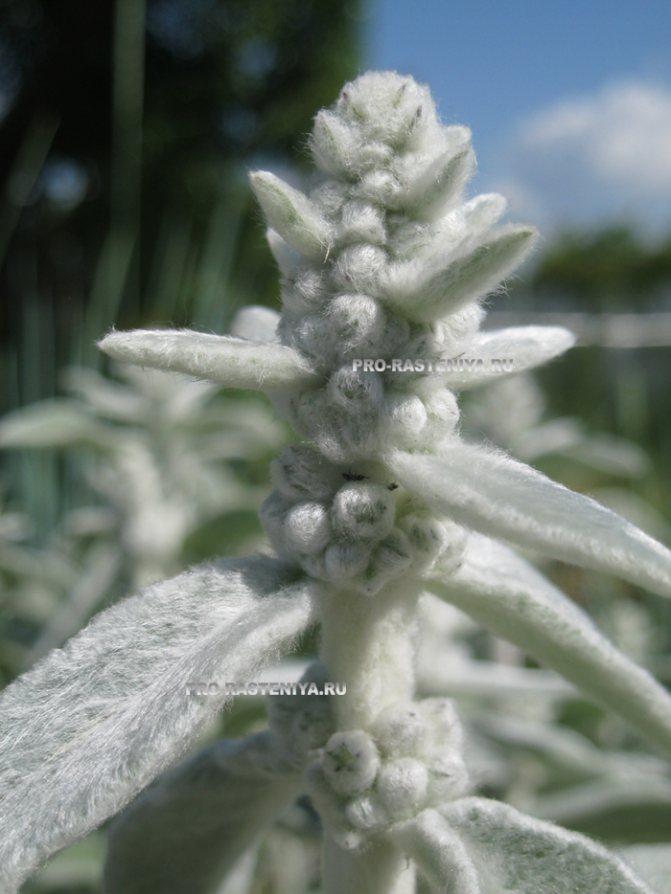


Decorative use
Woolly scrub is ideal for framing flower beds and borders. Various color combinations with other greenery and flowers allow florists to create new unique landscapes every time. Stachis is used in planting on alpine slides or horizontal rockeries. It looks good in combination with a two-color cross or splinter
, used to create compositions in silvery tones, goes well with stones, refined and elegant next to lavender,
ageratum
, Veronica and Carpathian bell.
Marigold
also look advantageous with a woolly chisel. Their orange color dilutes the silvery restraint of the stachis. Unusual compositions are made by woolly chisel with many deciduous ornamental plants: geykhera, hosts. Against the background of the woolly hen, the cypress spurge and the cuff are good. Sheep ears are also used in winter bouquets.
Interesting Woolly Facts:
Video: Woolly chisel (stachis)
• The composition of stachis contains essential oils, iridoids, alkaloids and flavonoids, a number of acids, tannins, vitamins (C and K) for food. The video shows how the Brazilian dish Lambari is prepared from a woolly puree
<сайт о="">
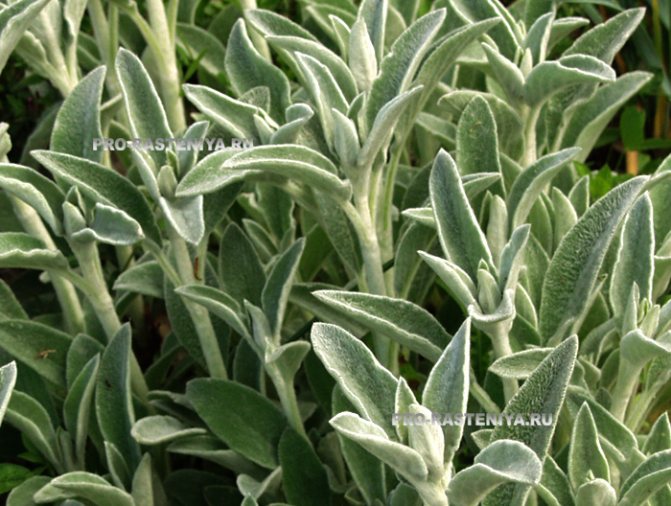

Photo: Woolly Chisetz (Stakhis, Stachys)
Back to section
» »
If you liked this article, please vote for it using your social network:
| <Previous | Next> |
The use of a cleanser
The procurement of raw materials is required when the purse blooms. The aboveground part is cut off and dried in the shady part with a slight breeze. Can be dried in attics with good ventilation.
In folk medicine, decoctions, infusions for the treatment of diathesis rashes and other skin diseases, gout, and nervous disorders are prepared from the aerial part of the plant. Fresh leafy plates are applied to bruises and cuts. Some recipes indicate that decoctions from the leaves of the purée are taken to lower blood pressure, uterine bleeding.
Now read:
- Delicate, easy-care coniferous bushes in garden plots
- Flowering of a capricious oncidium, after a neat transplant
- Effectively Get Rid of Whitefly Butterflies on Plants
- Indoor, flowering plants in the fight against spider mites
About
Agronomist of the state agricultural enterprise "Garovskoye" of the Khabarovsk region of the Khabarovsk region.
Growing and planting
The woolen purse is a light-loving plant that grows in well-lit and open areas. Although it feels good in partial shade. This is a winter hardy herb, so planting and caring for a woolly whale is not a big deal. It grows well in light soil with drainage, plant fertilizers and rotted manure. Gardeners note that the chisel grows well in regions with an arid climate. In conditions of high humidity, the plant quickly rots and its leaves lose their attractiveness.
Bunny ears tubers can be left in the ground for the whole winter. The growing season is from 130 to 140 days. You need to prepare a place for planting seedlings in June or July. For 1 square meter of area, you must add:
- 20 g of potassium sulfate;
- 50 g superphosphate.
You also need to additionally loosen the soil to a depth of 25-30 cm. After that, you need to eliminate weeds and add 10 kg of organic matter.
Planting for growing woolly stachis can be done in August. Between seedlings, an interval of 25-40 cm must be observed. It is better to select a light soil (loam or sandstone), with good drainage, moderate moisture and thoroughly fertilized.
Purée after flowering
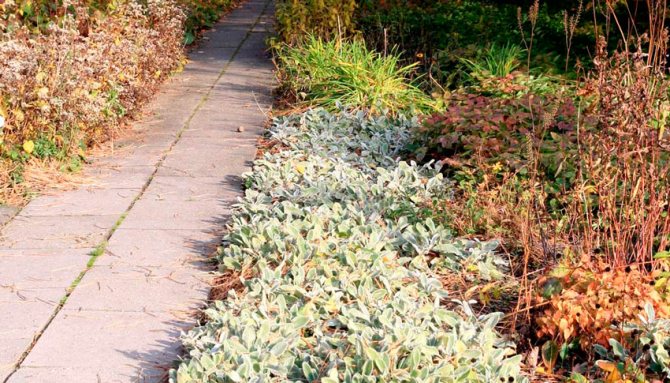

Perennial stachis is highly resistant to frost. But if forecasters predict a very frosty and little snow winter, then the bushes are best covered with spruce branches. It should be remembered that such a plant can die in spring if its root system is in the melt water for a long time. Therefore, when choosing a place for planting a purist, this must be remembered.
Using
The purist is widely used for the purposes of alternative medicine, for decorating the garden. An amazing bush is grown safely, does not require painstaking care, but it gives a lot of benefits.
Healing properties
The purist has a hypotensive, analgesic, cardiotonic effect on the human body. The plant stimulates contractions of the uterine muscles, is widely used in labor. It also stops bleeding. To lower blood pressure or reduce tachycardia, they resort to dry extract, decoction or tincture of purée. Broths help with colic, stomach cramps, colds, tuberculosis.
Alcoholic infusions are effective in the case of disorders and pathology of the nervous system.
Lotions from a decoction of purée are effective in case of eczema, mastopathy, scrofula. Medical fees are sometimes used for epilepsy, hysteria.
Garden decoration
The chastetz is widely used to decorate the suburban area. Plants are placed on an alpine slide, in rockeries, flower beds. The culture looks harmonious on curbs, intersections of garden paths, near stones. In rockeries or an alpine hill, due to the woolly chisel, they fill in the gaps. It goes well with other flowers of different colors. They also use the purse in floristry to create a base for winter bouquets.
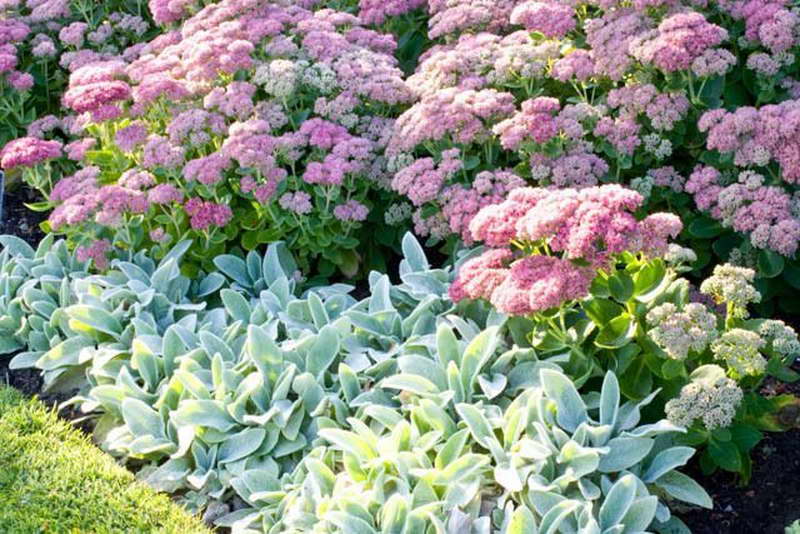

Reproduction methods
Reproduction takes place in a vegetative way, less often by seeds (this type of reproduction is typical for wild varieties). Ornamental crops are planted with seeds in winter in separate boxes. to get seedlings.
The most common and easy way to reproduce an ornamental purse is to divide the bush. Thinning perennial bushes, summer residents get new planting material. Delenki take root well. Most often, the transplant is carried out in the spring.
It is recommended to plant new plants at a distance of at least 15 cm. This is due to the plant's ability to grow. Delenki with 2-4 leaves are chosen as seedlings, these are rosettes that are easily separated from the mother bush.
Watering should be done with caution, since the rhizome is sensitive to excess moisture.
Woolly chisel
This amazing flower has a middle name that sounds like "stachis" and translated from Latin means "ear". So he was nicknamed for the shape of the inflorescences, tall, dotted with small pink or lilac flowers. But this is not at all for this he fell in love with gardeners! Chistets is known for its silvery velvety leaves that look great in any mixed planting, be it a flower bed, or curb, rocky hill, or lawn. Types of flower beds.
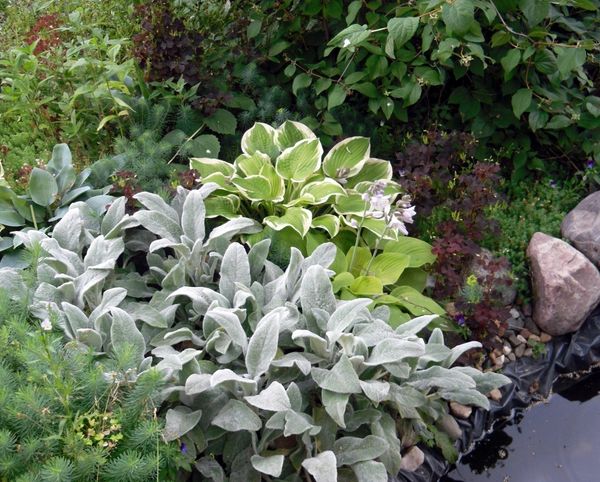

However, not all varieties can boast spectacular foliage. As many as 300 different species are collected within one genus, most of which are nondescript, wild-growing dwarf shrubs. On the territory of Russia, marsh and forest purses are most often found. Describing the habitat of these ubiquitous plants, it is easier to say where they do not grow. For example, the Chistess did not make it to Australia and New Zealand. Otherwise, it is ubiquitous.
On a note Although nature has not endowed the forest purist with outstanding external data, in return, this species has medicinal properties. So, its calming effect on the nervous system surpasses even motherwort.
And yet, speaking about ornamental floriculture, you need to focus on one variety - the Byzantine purse, or woolly. It is its foliage and shoots that have dense pubescence, making the plant incredibly pleasant not only to the eye, but also to the touch. Soft hairs are like fur, which makes it seem that the flower is not real, but plush. The silvery color of the foliage makes it visible anywhere. It looks especially good in combination with bright green foliage. His duet with roses is unique! Cleaner photo.
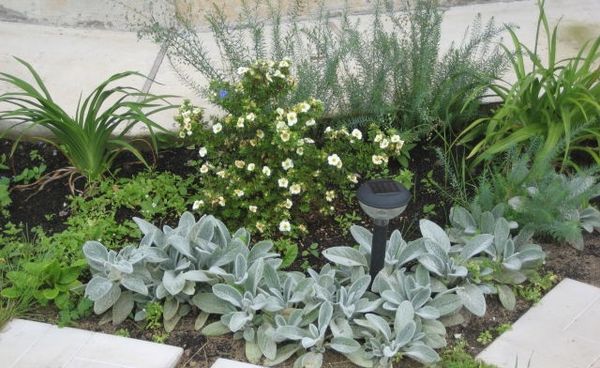

This species is widespread in the southern regions of Russia, on the Black Sea coast, in the Caucasus, also in Turkey, Armenia. By the way, despite the decorative effect, the leaves and roots of the plant are also saturated with chemical compounds. But still, admiring it is much more pleasant than using it as a medicine!
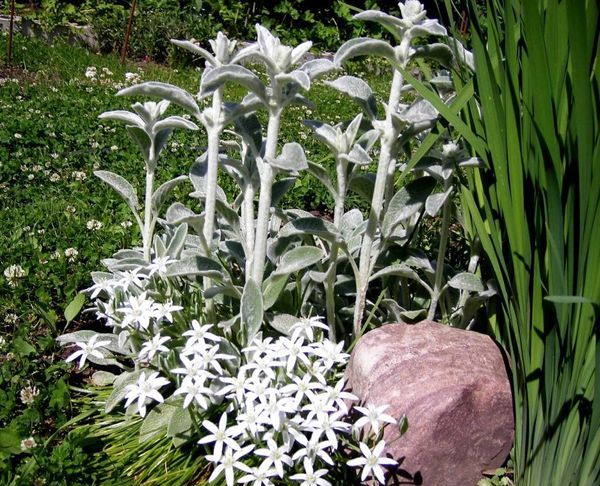

The woolly chisel is popularly nicknamed "sheep's ears" for its bizarre appearance. In nature, he prefers stony soils, does not like stagnant moisture. Therefore, it is ideal for rock gardens and sunny areas. As soon as he appears in the garden, he will become your favorite!
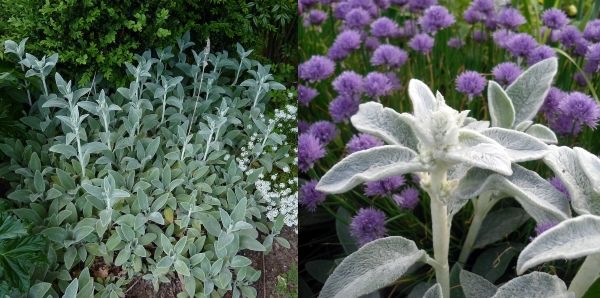

h. Byzantine
Among other varieties, flower growers may be interested in large-flowered chisel, the leaves of which do not have pubescence, but the flowers deserve attention. In summer, it forms large, tall peduncles with bright lilac petals. An impressive sight!
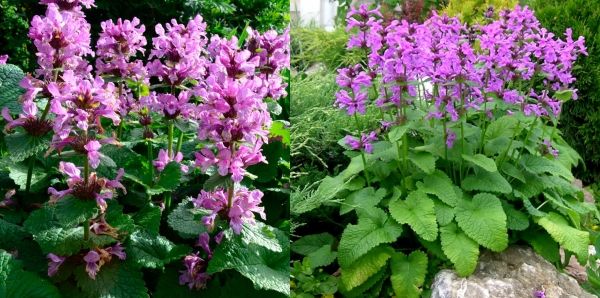

including large-flowered
Biological features of stachis
The chisel is common on all continents except Australia. There are more than 300 species. About 50 varieties grow in different regions of Russia.
Height is about 1 meter, pubescent leaves are a characteristic feature. The shape is found in various - heart-shaped, serrated, oval.
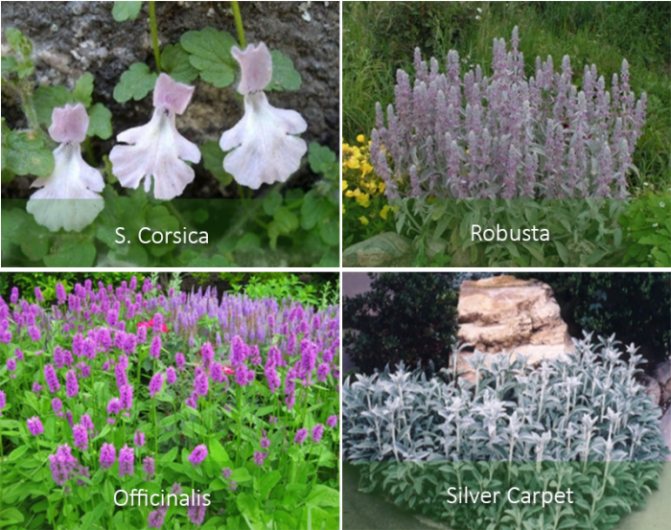

In Latin, "stachis" means "ear". Stachis inflorescences are collected in an ear. The flowers are small, bell-shaped, pink, purple, lilac, lilac, yellow and white.
Flowering from May to August. Fruits in the form of a nut.
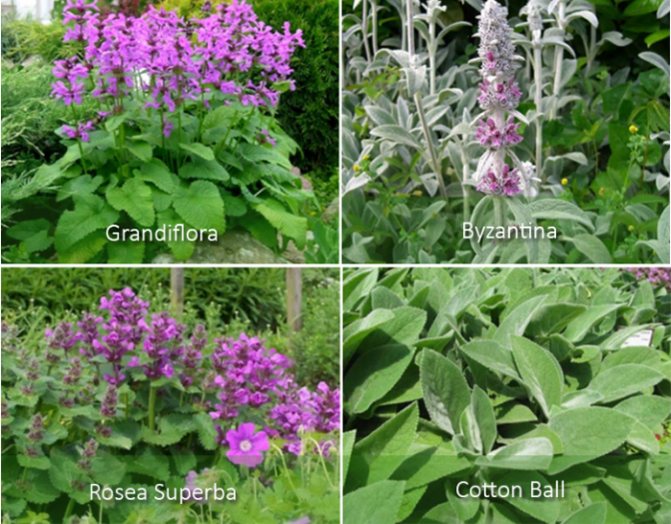

Description of Woolly Stakhis
Woolly Stachys, Stachys byzantina, Sheep ears are all one and the same plant. The genus of Chistets includes more than 400 species, but it is the woolly varieties that are distinguished by their increased decorativeness.
A low shrub, rarely reaching a height of more than 60 cm, stands out favorably against the background of vegetation familiar to our eyes. Oval leaf blades are covered with thick silvery villi. Thanks to this feature, incredibly soft and pleasant to the touch leaves are boldly knocked out of the general color scheme. Stems are erect, fleecy, with a small amount of foliage on them, crowned with a false spike of 6 - 10 flowers, lilac, blue or pink.
Read also: Planting and growing an elm
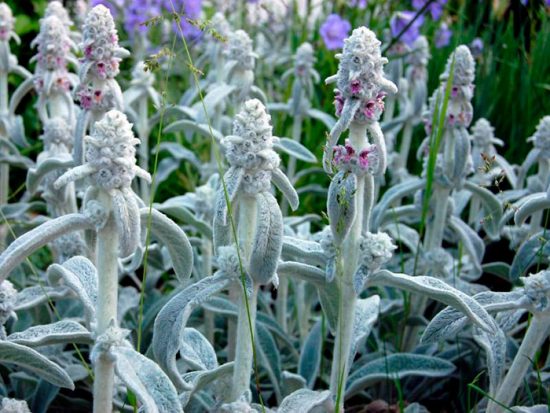

Flowering begins in mid-summer and lasts until September. The seeds look like small triangular nuts, brown in color.
16 excellent varieties of plums for the Moscow region
Stakhis feels great in the southern and central zone of the Russian Federation, in Altai and in Western Siberia, but it can grow in colder climatic zones.
Planting a flower
Byzantine chisel propagates in the form of seeds by dividing the bush and tubers. Seeds are sown in containers with soil in mid-February or early March. After watering, they should be covered with plastic wrap and placed in a warm room. After a month, you can observe the first shoots. And when pairs of leaves have formed, the seedlings can be planted in open ground. But you need to take into account the forecast of frost, otherwise the Byzantine Chisinau will simply die.
An ideal place for stachis can be considered an area with partial shade, where the sun's rays fall well. But the shrub is not picky about the condition of the soil, apart from moisture. Sheep ears (another name for the plant) adapt to any soil. But the most optimal are the lungs, with moderate fertility. If the soil is oversaturated with mineral fertilizers, the plant may lose its decorative qualities, and instead of a silvery shade, the flower will have an ordinary light green color.
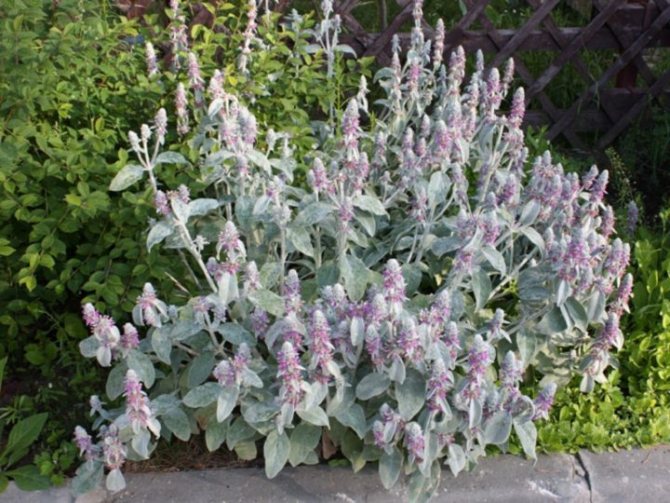

Basically, the process is as follows:
- Plant holes should be 13-18 cm apart.
- Coarse sand, pebbles or small stones must be poured at the bottom of each depression, and sprinkled on top with a layer of soil with fertilizers.
- Seedlings are planted in the holes, then watered abundantly.
Next, you need to regularly water the plant, clear the weeds around and loosen the soil. When the first flowers appear, you need to spud it.
It must be borne in mind that it is recommended to water in moderation, otherwise moisture stagnation may appear in the roots of the purée. Experienced gardeners advise watering the woolly stachis abundantly in dry times so that the plant does not shed its leaves.
Some gardeners practice stachis propagation using tubers. The whole process, which is very similar to planting ordinary potatoes, boils down to the following steps:
- A small depression is made in the form of a groove up to 5-6 cm in depth (if the soil is sandy, up to 7-8 cm), the distance between the rows is recommended at least 50 cm.
- Tubers prepared and cleaned of dirt are immersed in the ground with an interval of 20 cm.
- Everything is sprinkled a little with humus or suitable mineral fertilizers.
- Abundant watering is in progress.
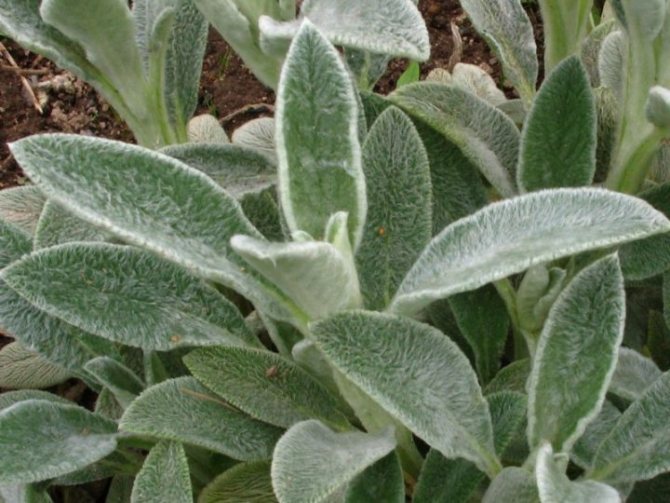

That's it, this completes the procedure. It remains only to wait until the plants sprout first. By the way, the collection of tubers for the next planting is carried out in the fall by simple digging.
Popular varieties of stachis or woolly chisel (with photo)
Woolly chisel (Stachys lanata).
Hearing the strange name of a flower stachis or woolly or sheep's ears, many gardeners are interested in what kind of plant it is and how it looks, whether it looks in the garden.
Meanwhile, this is the most common and spectacular type of chitosene, which is a plant with a height of 45 - 50 cm with straight, tetrahedral, slightly leafy stems. Its leaves are spatulate or oblong-oval, dense, leathery, light green, pubescent, with silvery-white hairs. The flowers are lavender or lilac, collected in a spike-shaped inflorescence.
Varieties of woolly chisel:
"Helen Von Stein" - has large spatulate leaves with a rough surface. Shoots of a blue tint, have dense pubescence;
"Big Ears" - a low-growing popular variety with large, densely pubescent leaves up to 20 cm long;
Sheila Macqueen - a compact plant with a height of 15 - 20 cm. It has small oval leaves of a gray shade with a white pile on the surface. The variety does not bloom. It is a ground cover;
Striped Phantom - a beautiful variety with oval leaf plates of a blue hue.There are longitudinal stripes on the surface of the leaves. The flowers are small, rich yellow;
"Silver Carpet" Is a non-flowering variety that is valued for its numerous silvery foliage densely covering the bush.
The next photo shows a stachis or woolly sheep's ears, you can see its differences from other varieties:
Woolly chisel: description, reproduction, planting and care
Woolly chisel is a herbaceous crop of the Yaroslavl family, growing in coniferous and mixed forests, in forest and forest-steppe areas. The plant is also cultivated in home gardens for future medical use. Popular names for the chisel are hare ears and the Byzantine chisel. The first name was invented because of the white edge on the leaves of the culture.
This plant is considered perennial, has massive elongated leaves tapering downward. They seem to be wrapped in light gray down, which makes them especially decorative and beautiful. This is the beauty of the woolly purse. His photo is presented below.
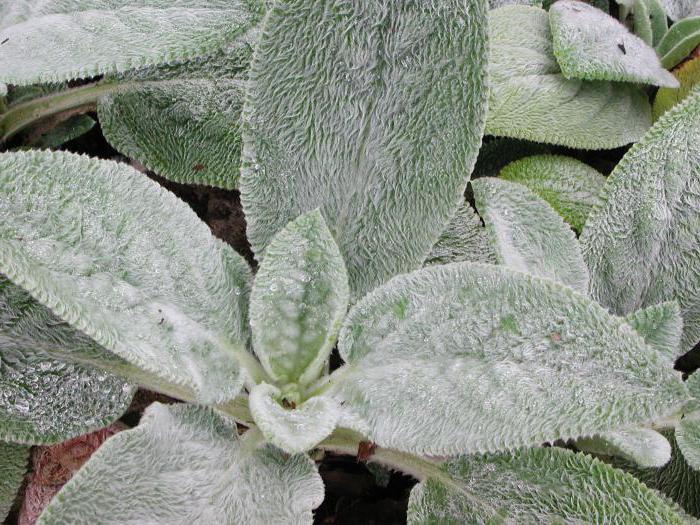

The flowers of the culture are small, lilac-pink and lilac in color, in dense spike-shaped inflorescences, placed on oblong peduncles. Chisetz blooms in June-September. Due to the fact that the peduncles are elongated, they often fall on the ground due to rains.
Application in garden decoration
The unique appearance of stachis allows you to diversify garden compositions. In addition, the plant is able to decorate flower arrangements. It is used by:
- When creating edging for garden paths and flower beds. Fluffy leaves look great in multi-layered borders.
- As the main and additional element in rockeries, rock gardens or flower beds.
- As a garden decor as an ampelous plant. When planted in a pot, you can hang it on the terrace or balcony.
- For drawing up live and dry floristic compositions. The foliage retains its decorative appearance for a long time.
The plant is combined with flowering and deciduous crops. For example, excellent combination with marigolds, bellflower, ageratum, deciduous crops: hosts, milkweed, conifers dwarf shrubs.
Chisel properties
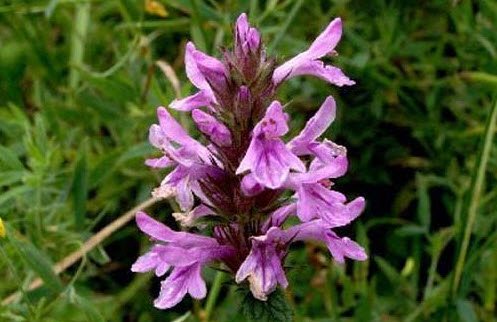

Among the many types of chisel there are those that stand out for their healing properties. They are widely used in alternative medicine. For example, the woolly chisel is not one of the pharmacopoeial plants, but at the same time it is often used in folk medicine, because it has a hypotensive, antispasmodic, cardiotonic and hemostatic effect. Means made from such a plant (tincture, decoction or dry extract) are used in the treatment of colds, tuberculosis, mastopathy, nervous system disorders, eczema, scrofula and other diseases, as well as to lower blood pressure.
Wood scum is widely used in obstetric and gynecological practice, both in traditional and alternative medicine. Funds made from it have a powerful hemostatic effect and are used for any uterine bleeding. Means made from the aerial part of the purifier have a wound healing and anti-inflammatory effect, they are used in the treatment of hemorrhoids, ulcers, eczema, purulent wounds and cuts. Chisetz is a part of the collection, which improves the blood supply to the brain, they are used in the treatment of epilepsy, hysteria and fainting.
It should be remembered that such a plant has contraindications. It is forbidden to use it for treatment for patients with nephritis, hypertension, hepatitis, bronchial asthma, as well as for convulsions and angina pectoris, as well as during pregnancy and lactation, and children. You can not use the purifier to treat people with an individual intolerance to this plant.
Types and varieties of chisel
Woolly chisel (Stachys lanata)
There are not many types of chitose cultivated in the culture.Most often on flower beds you can find woolly chisel, or woolen chisel, or Byzantine chisel, or “sheep's ears” chisel (Stachys byzantiana). This plant comes from the Transcaucasia, northwestern regions of Turkey and Iran, and from the south of the European part of Russia. It is a rhizome perennial with a height of 20 to 60 cm with tetrahedral, erect and slightly leafy stems, thick spatulate or oblong-linear leaves, narrowed towards the base and densely pubescent with white felt. The flowers of this species are small, lilac or mauve, collected in dense spike-shaped inflorescences. In culture, the species has been since 1782. The most famous variety of the species is Silver Carpet - a plant only 15 cm high, forming a dense silvery carpet.


One-year old purse (Stachys annua)
distributed in Europe, Asia Minor and Western Siberia. Its stems are 15 to 35 cm high, simple or branched, usually bare below, shortly pubescent at the top. The lower leaves are crenate, oblong, wedge-shaped at the base, the upper leaves are sharp, serrate, lanceolate, sessile. Whitish-yellowish flowers are collected in long spike-shaped inflorescences. The fruit is a nut. The one-year-old is a honey plant.
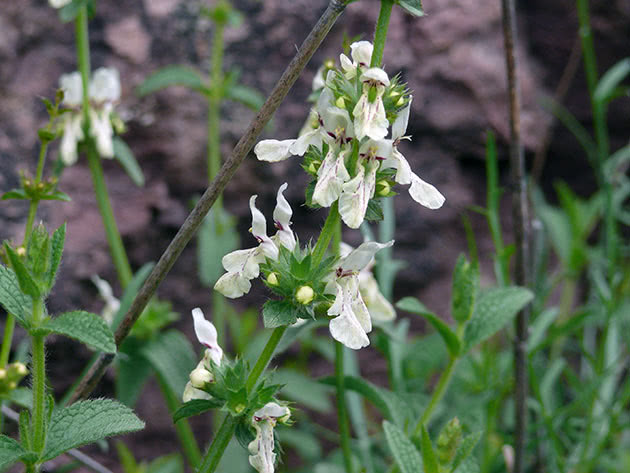

Forest chase (Stachys sylvatica)
grows naturally in Turkey, the Caucasus, Europe, Central Asia, China and Russia. The plant reaches a height of 35 to 120 cm. Its stems are straight, ascending, soft-haired. Stem leaves are petiolate, crenate-serrate, pointed to the apex, ovoid-cordate, and the apical leaves are sessile, oblong, whole-edged, light green on the upper side, gray-green below. Inflorescences are long, six to eight-flowered.
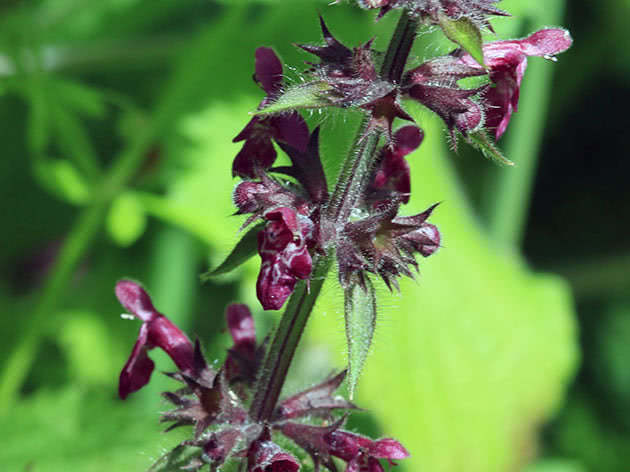

Marsh chase (Stachys palustris)
or thistle, or chernosebennik, or grate, or tenacious distributed throughout Europe, in regions of Asia with a temperate climate from China to Iran, in Turkey, Siberia and the European part of Russia. The plant reaches a height of 120 cm. It is densely pubescent with rough long hairs. The lower leaves are oblong, sharp, round or cordate at the base, finely toothed at the edges, and the upper leaves are entire, ovate-lanceolate, sessile, long-pointed. Spike-shaped inflorescences consist of 6-10 purple-purple flowers.
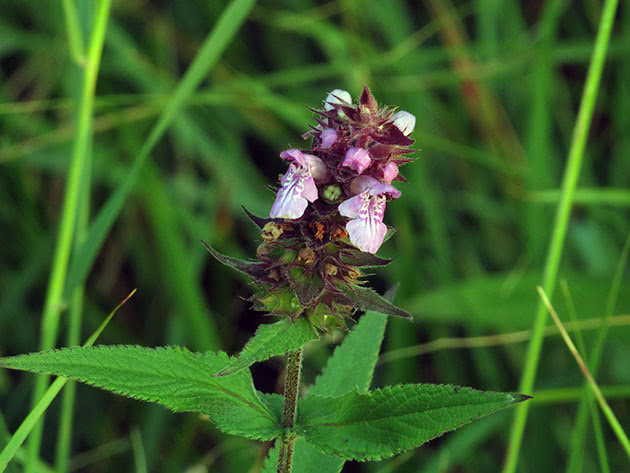

Grandiflora (Stachys grandiflora)
grows in the Caucasus and Asia Minor. It is a perennial from 20 to 30 cm high. Its leaves are long-petiolate, cordate or rounded, crenate along the edge. Large flowers are collected in capitate inflorescences and are located on a leafless peduncle up to 50 cm high.This plant has several decorative forms, for example:
- Spirea: description of planting and care, types and varieties
- alba - with white flowers;
- superba - with pink to purple flowers.
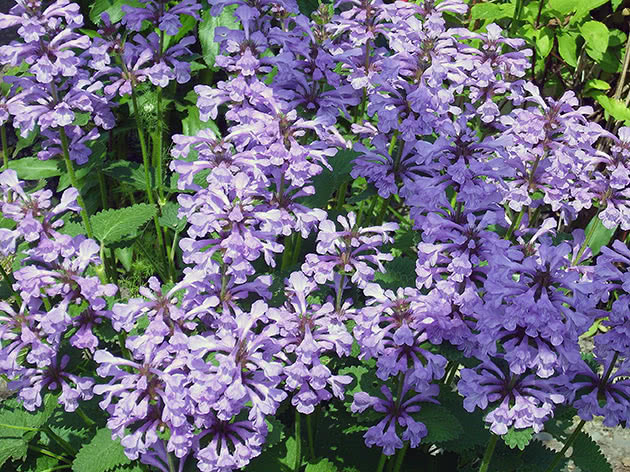

Officinalis (Stachys officinalis)
is a Eurasian species with a wide habitat from 50 to 100 cm in height with crenate, oblong, heart-shaped at the base ovoid leaves. Basal leaves are long-petiolized, upper leaves are almost sessile. The spiky inflorescence consists of purple or dark pink hairy flowers.
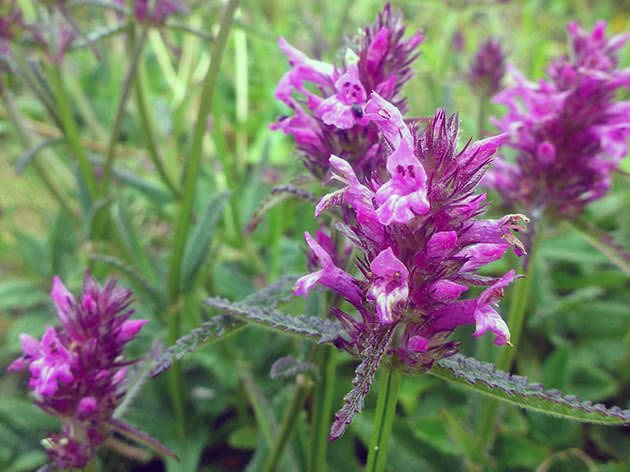

In addition to the species described, fluffy, alpine, lavender, straight, narrow-leaved, field, Germanic, Cretan and many others are also known.
Popular varieties
The genus has about 400 species of plants, but only about ten have become popular with gardeners and designers.
Woolly chisel, or stachis. An ornamental culture that gardeners fell in love with because of the bizarre shaggy leaves. This is a hardy and unpretentious plant. It blooms from June to September with pink-purple flowers. Main varieties:
- Silver Carpet - undersized variety, bushes up to 15 cm high. When growing, forms a silvery-green carpet;
- Striped Phantom - characterized by the presence of white longitudinal stripes on the surface of the leaves;
- Sheila Macqueen is a herb without flowering.The variety is distinguished by low shoots and leaves pubescent down;
- Big Ears is a medium sized herb. They are covered with shaggy long leaves (25 cm).
The forest chase grows in Western Asia and Europe. It is a medium-sized plant with dark green leaves. Crimson inflorescences. It is a forest herb that is used in folk medicine as a hemostatic and sedative.
Another popular type of culture is the Byzantine Chistets. It is a herbaceous perennial crop. It grows mainly in the countries of South Asia, but is also found in the European part of the continent. Has a characteristic aroma. The juice contains a large amount of essential oils and vitamins of group C, therefore it is used as a medicinal plant.
The one-year-old purse is a large herb-honey plant. It grows in forest areas, as well as in the meadows of Europe and Asia.
The largest representative of the species is the marsh chase. The growing environment is a marshland. It is a tall herb with a powerful stem. The leaves have small denticles along the edge. Both the stem and the leaves are covered with fine villi. It is used in folk medicine as an infusion for wound healing.
Description of culture
The Chistets belongs to the Yasnotkov family. Under natural conditions, the culture grows in the temperate zone: Europe, South and North America, Africa. It is an unpretentious herb that is used as a decoration in landscaping or floriculture.
No wonder he was given the name "woolly", the leaves are covered with soft-touch hairs that resemble animal hair. The leaves are elongated, in the form of "hare ears". The leaves are collected in rosettes, in the center of which a long stem with inflorescences appears during the flowering period. The height of an adult plant is up to 30 cm. Flowering is observed from June to September. Inflorescences have bell-shaped cups with sharp petals. The color can be yellow, pink, white or lilac, depending on the type of plant.
The flower is replaced by a fruit-box: a nut with three sides. Inside it are the seeds of the purifier. To achieve some decorative purposes, gardeners cut off flowering shoots, in this case the plant is used as a low-growing framing of country paths, flower beds or part of a panel composition andplants of different colors.
The roots are not branched, they go deep into the soil. On the rhizome, you can see small elongated tubers.
It is a perennial plant that predominantly reproduces by dividing the bush. Much less often seeds or tubers. Reproduction by dividing the bush also has a purely practical function: the purse grows quickly, and in order to control its shape, it is worth periodically thinning the bushes.
Reproduction of the chisel
The plant is bred by cuttings, dividing the bush and seeds. The most popular way is the first. When the culture is propagated by seeds, the bushes are formed later.
Division of bushes
After 2-3 years, the purse is subject to division. In the spring, the bush should be dug out with a lump of soil, manually divided into a couple of parts, and planted in separate holes at a distance of 20 cm from each other.
Cuttings
Plant shoots with 3-4 leaves in a wet mixture of sand and peat. Water sparingly to prevent rotting. When the first signs of growth are formed, you can sit separately.
Seeds
Seeds germinate without problems, quickly, but this method is the longest. Pour a combination of peat and sand into a wide container, distribute the seeds on top, sprinkle with a thin layer of sand, spray from a spray bottle. You do not need to cover the containers, but irrigate the ground every day. The temperature in the place should be within 25 degrees Celsius. Adequate lighting is required. If necessary, thin out dense seedlings. After the development of seedlings, they are planted in a permanent place in the garden.
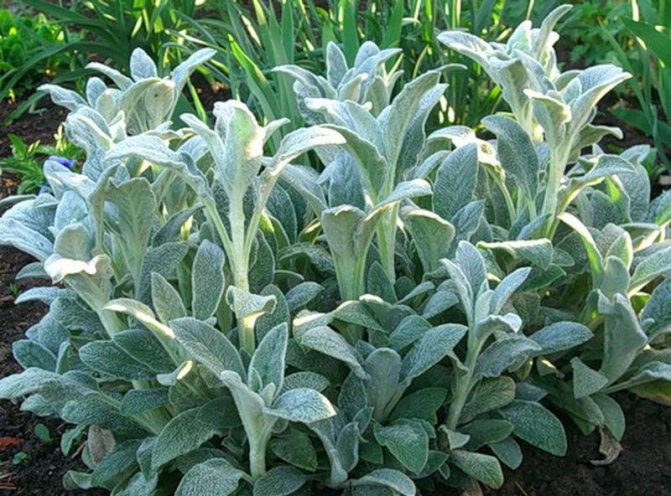

Landing space
It should be borne in mind that when grown in too fertile soil, stachis leaves may simply turn green, ornamental pubescence will be lost. The best option would be loose soil of medium fertility.
Suitable for planting are areas under bright lighting, as well as in the diffused shade of shrubs and trees. In cold light, the texture of the leaves stands out very effectively.
Cannot be grown in lowlands and flooded areas, since dampness is the main "enemy" of stachis.
Botanical description of the plant Chistets (with photo)
According to its botanical description, stachis is an annual or perennial herb, less often a shrub, reaching 50 cm in height or more. Stems are straight, slightly branched, thin, but strong, pubescent, moderately leafy. The roots are powerful, thick, fleshy, tuberous.
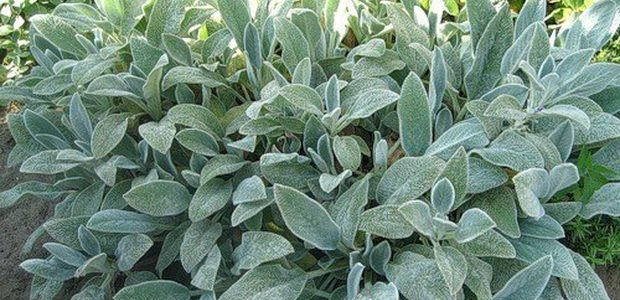

Leaves are opposite, oval or lanceolate, entire or toothed, covered with short, silvery hair. Attached to short petioles. The leaf plates are gray-green in color.
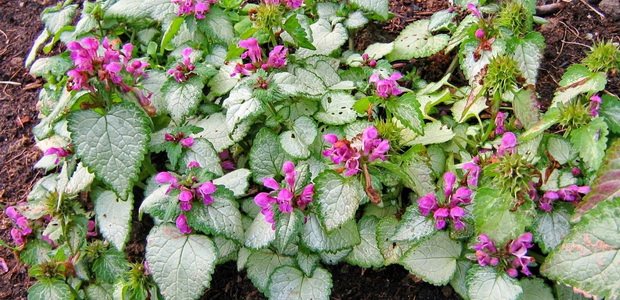

In the upper part of the stem, an inflorescence is formed - a false ear, consisting of 6 - 10 flowers of white, pink, yellow, pale blue, purple, lilac hue. Bell-shaped flowers with five petals pointed at the base. Bloom lasts from July to September.
The fruit is a round or oval triangular nut with brown seeds inside.
In floriculture, perennial species are mainly used.
The description of the plant is supplemented by the photo below, where you can clearly see the features of its leaves and flowers:
What does the cleaner look like
The purse can be grown as both an annual and a perennial plant. It belongs to the family of lacustrine plants. The bush has an elongated branched rhizome that penetrates deep into the ground. Typically, the scrub is about 20-30 cm high.
Root shoots are thickened, they have elongated tubers. The root rosette is foliage with erect shoots that do not branch too much. The deciduous part is heart-shaped, the length of each leaf is up to 10-12 cm. The leaves are attached to the stem with stalks in a checkerboard pattern. The foliage at the top of the bush is ovoid.
The surface of the leaf plate of almost all varieties is distinguished by a long, silvery edging. And the foliage itself is usually painted in a bluish-green color. Thanks to this natural decoration, the foliage is similar to a sheep's ears or a felt patch.
In the warm season, the purse begins to bloom from July to the first autumn month. When flowering, the culture throws out numerous elongated inflorescences with yellow, snow-white or pinkish buds. The buds are similar to five-star pointed bells.
When pollination occurs, fetal development can be observed in the central part of the calyx. This is a small triangular nut. The smooth skin of the fruit is dark brown.
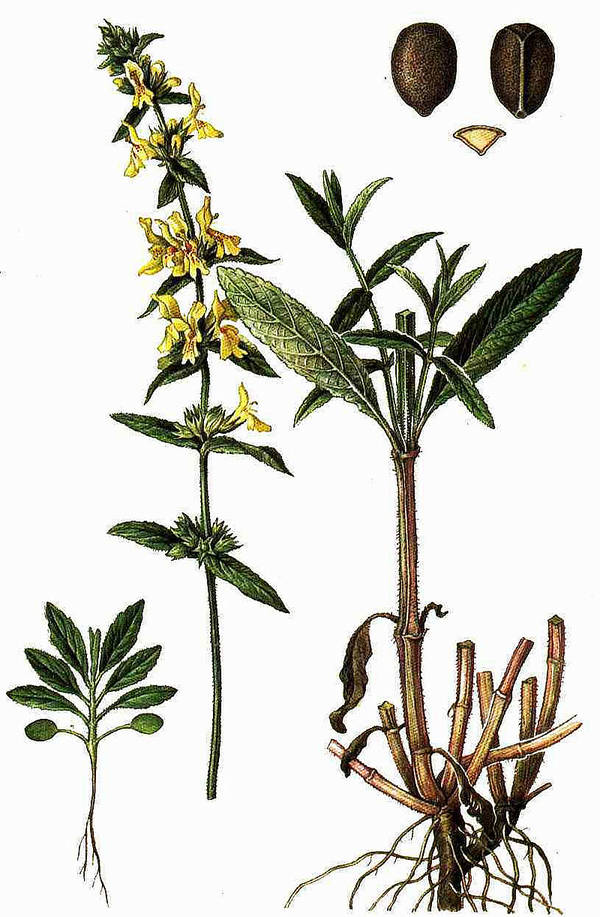

Growing conditions
The plant is very fond of light, grows remarkably in open and sunny areas, but it can also be bred in partial shade. The culture is winter-hardy, it prefers light drained soil with a certain composition of rotted manure or plant fertilizer. Woolly cleaver develops very well in dry areas. In moist soil, it quickly rots, and the luxurious pubescence of its leaves is lost. Tubers left in the soil for the winter season do not die. The growing season of a flower is 130-140 days.
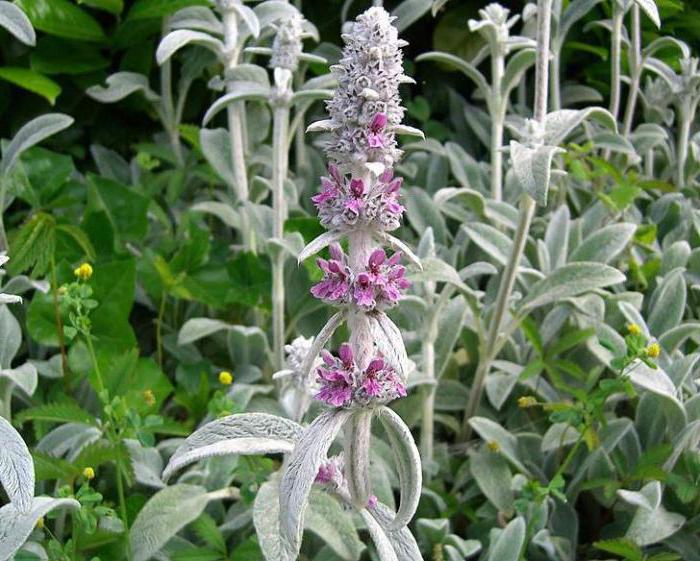

Description and features
The bush consists of leaves covered with dense pubescence along the entire back side. Sheep ears grow up to 100 cm high. The leaf plates are located opposite, they are solid or serrated. Flowers are part of false whorls that form spike-shaped inflorescences. Their color is purple, yellow, lavender, pinkish or white.
The fruit is a triangular nut, ovoid or oblong in shape. The representative of the flora is unpretentious, it can even withstand hot, dry days.The optimum temperature for a plant is 20-25 degrees Celsius. Cold weather is not terrible for the cleanets, under a thick layer of snow, he safely endures the winter. The annual bush is valued by beekeepers as a good honey plant.

